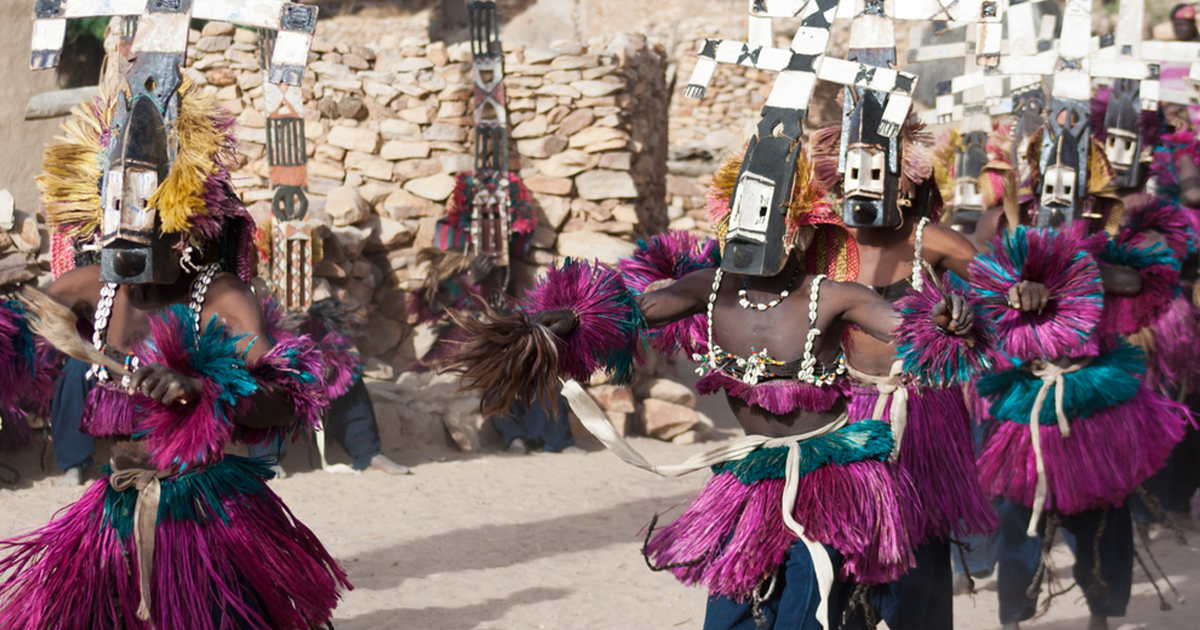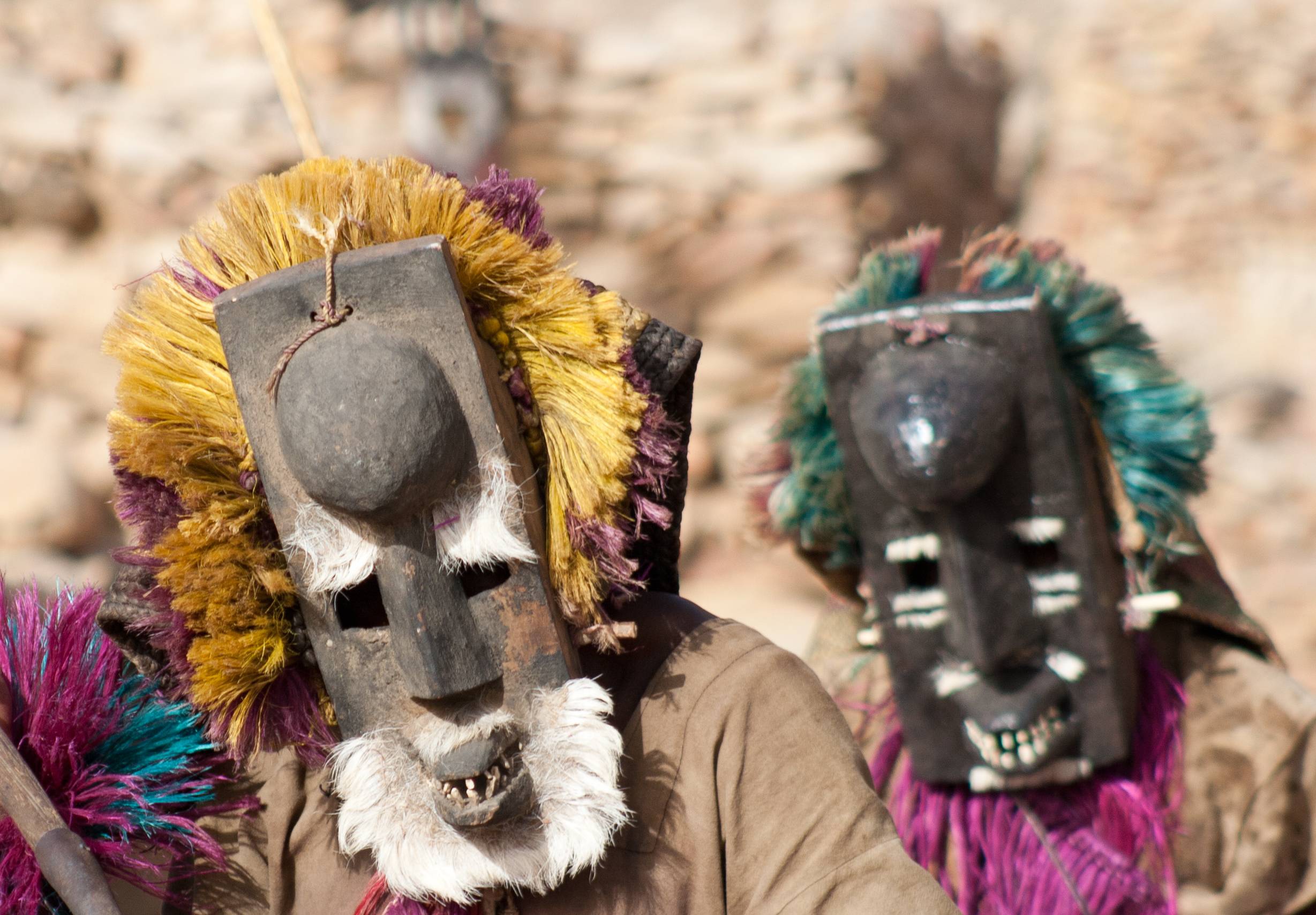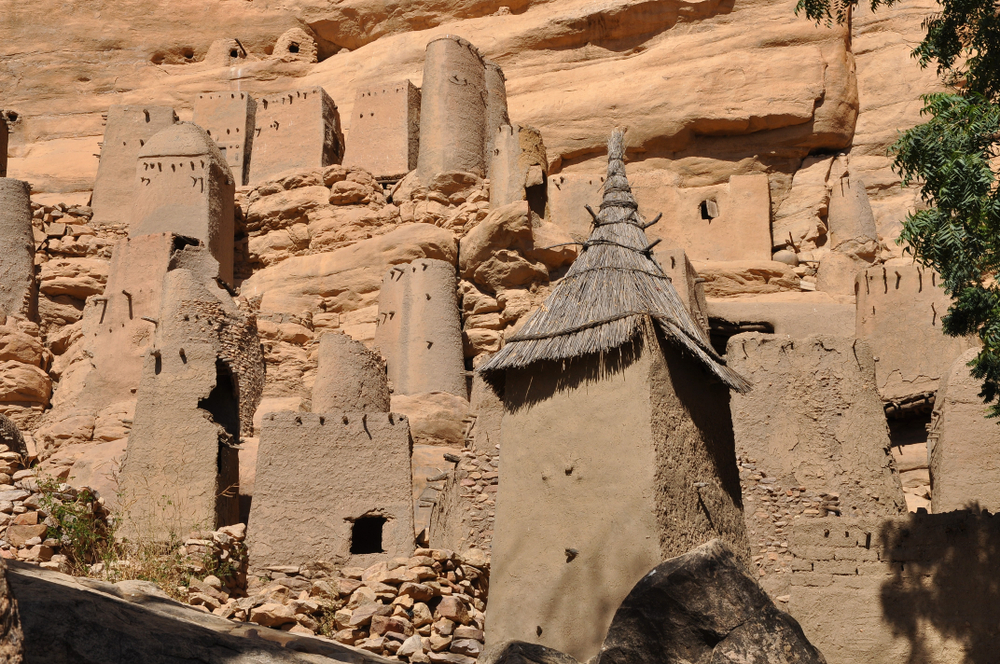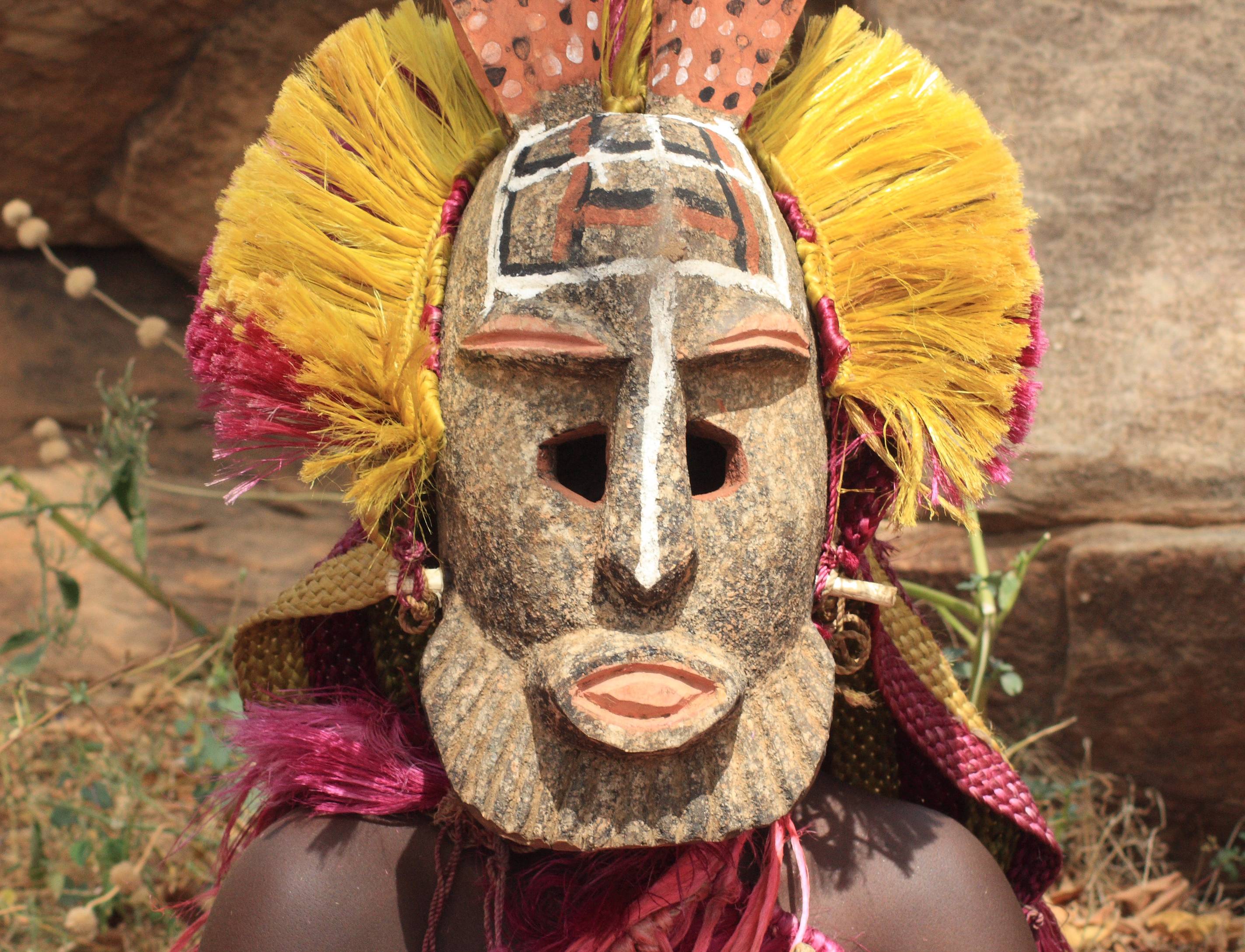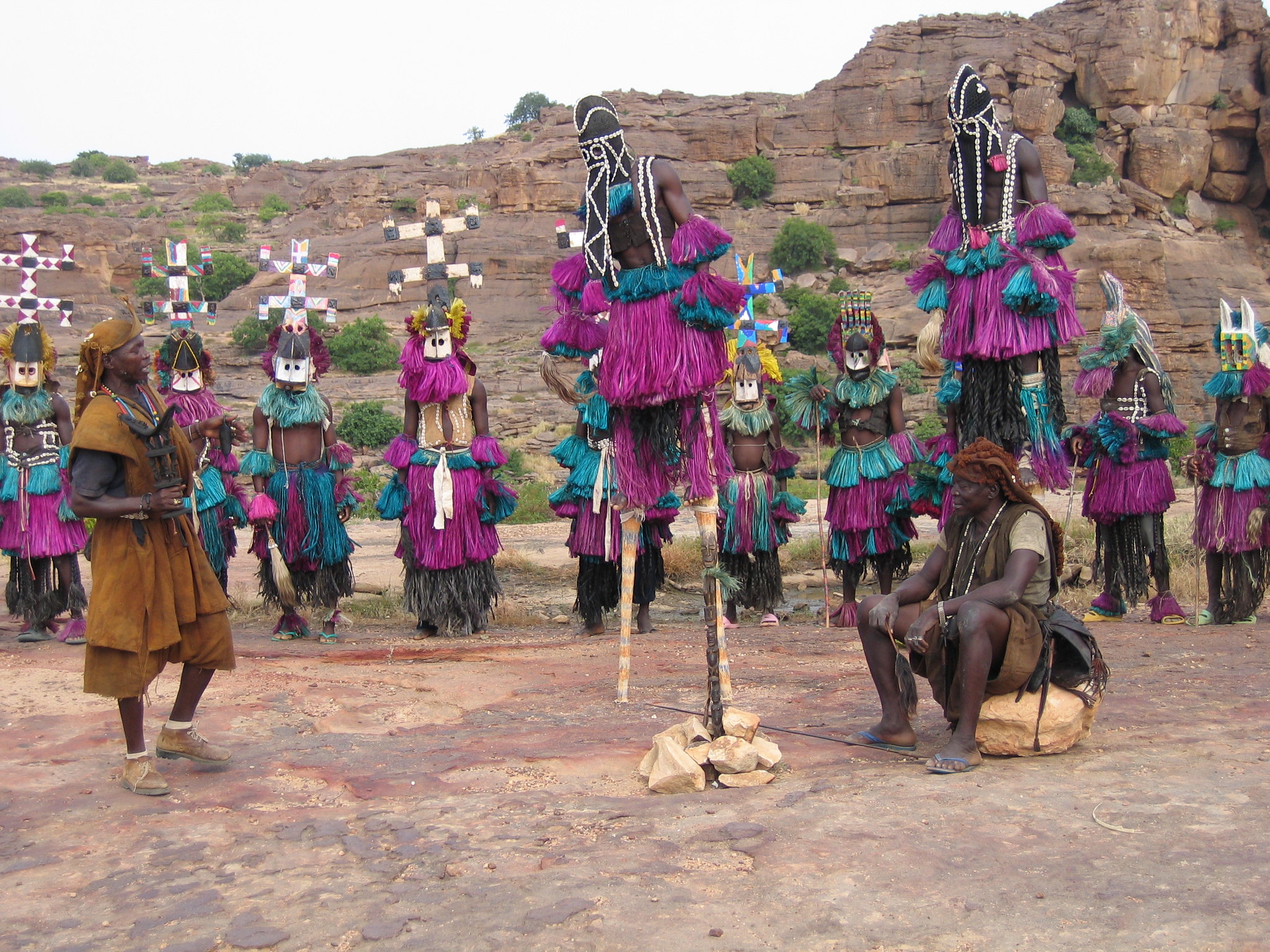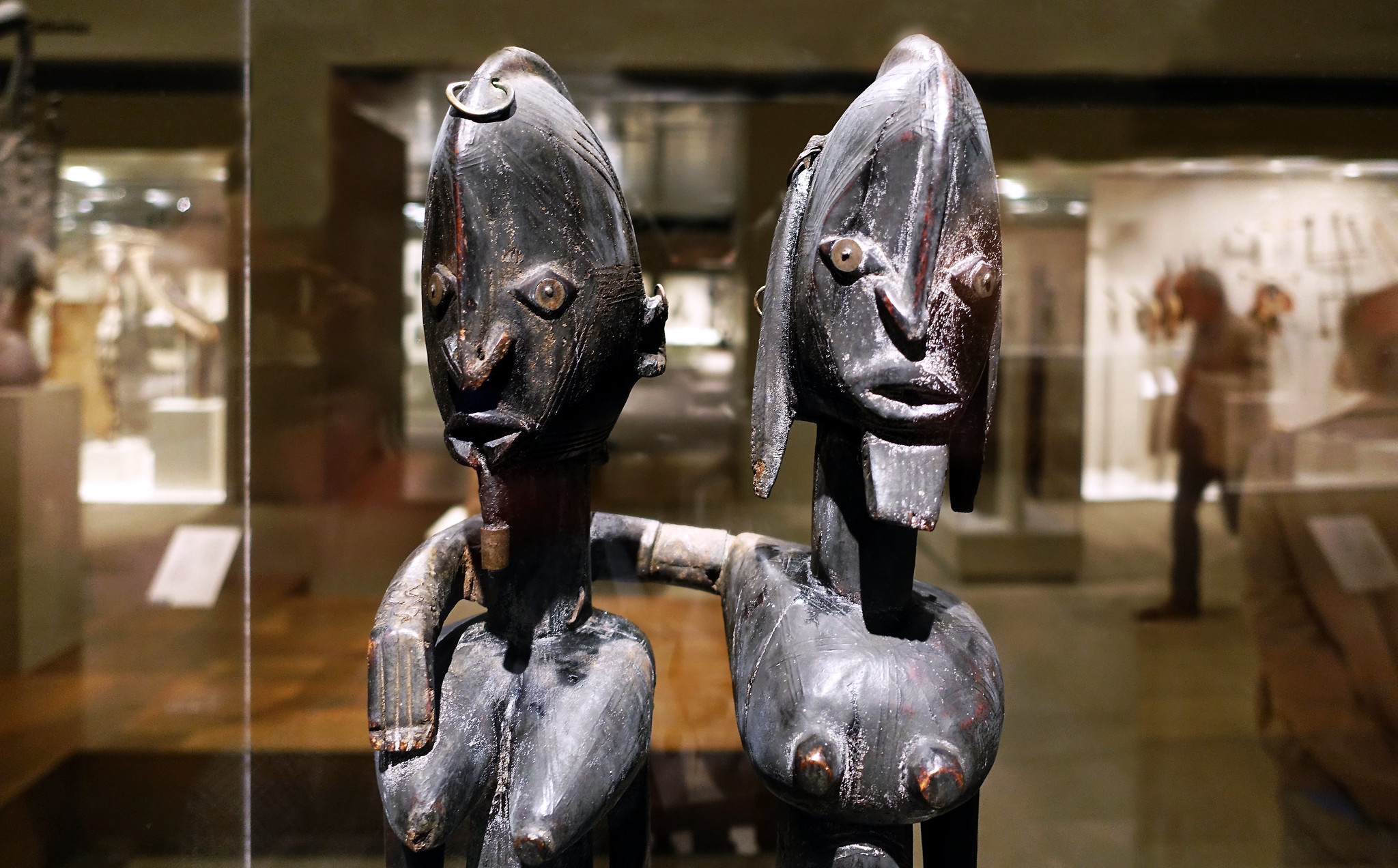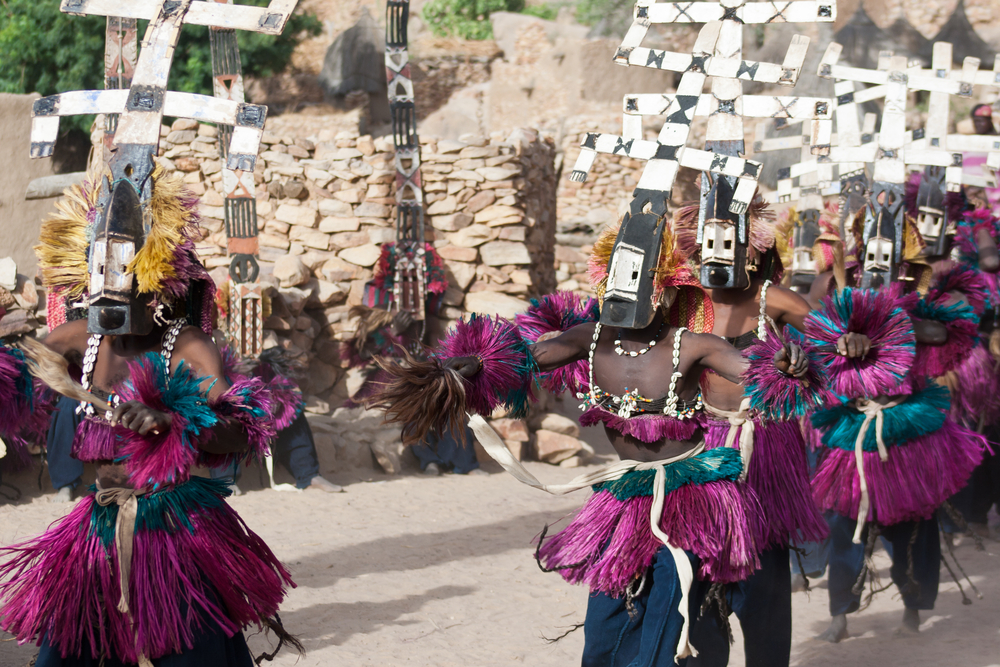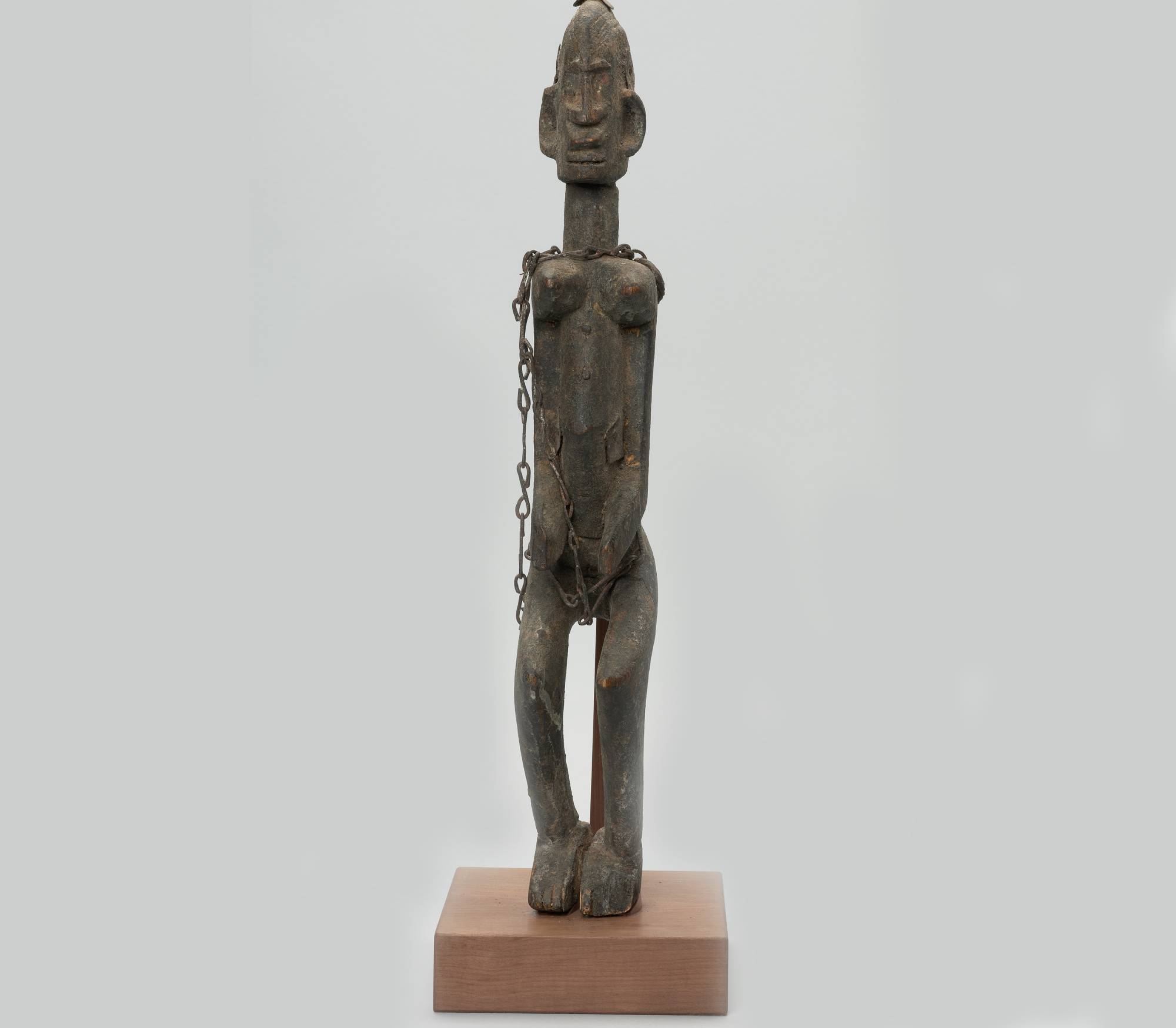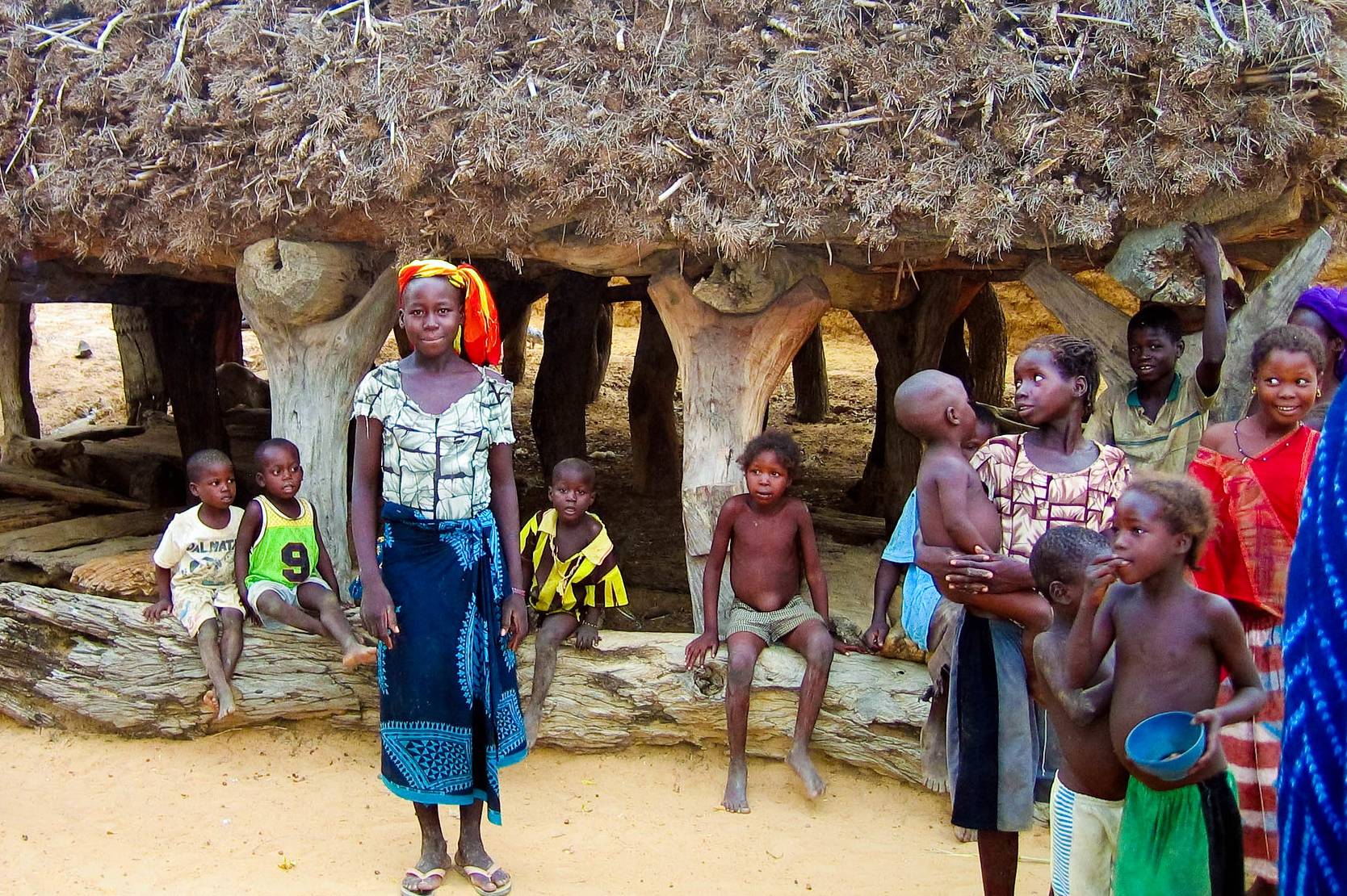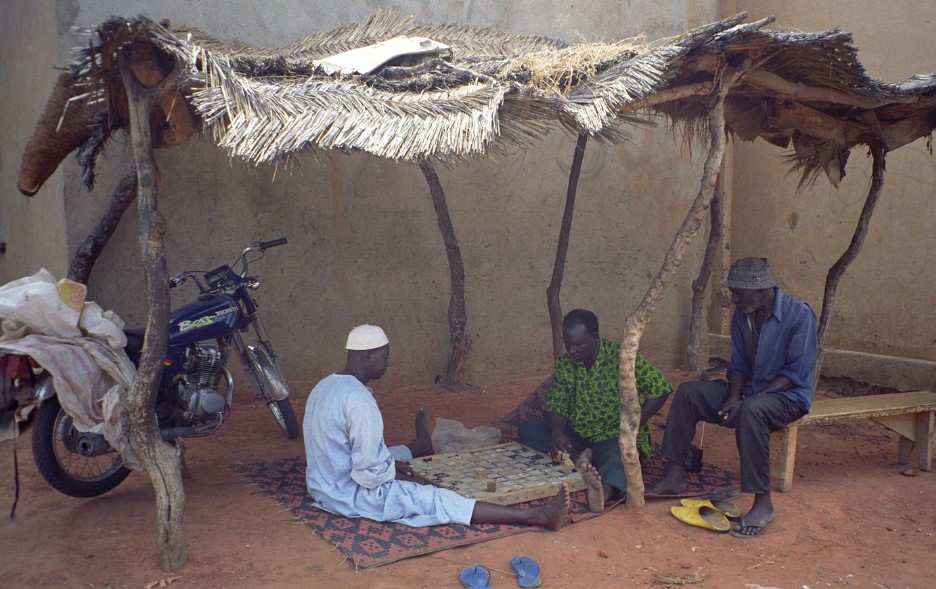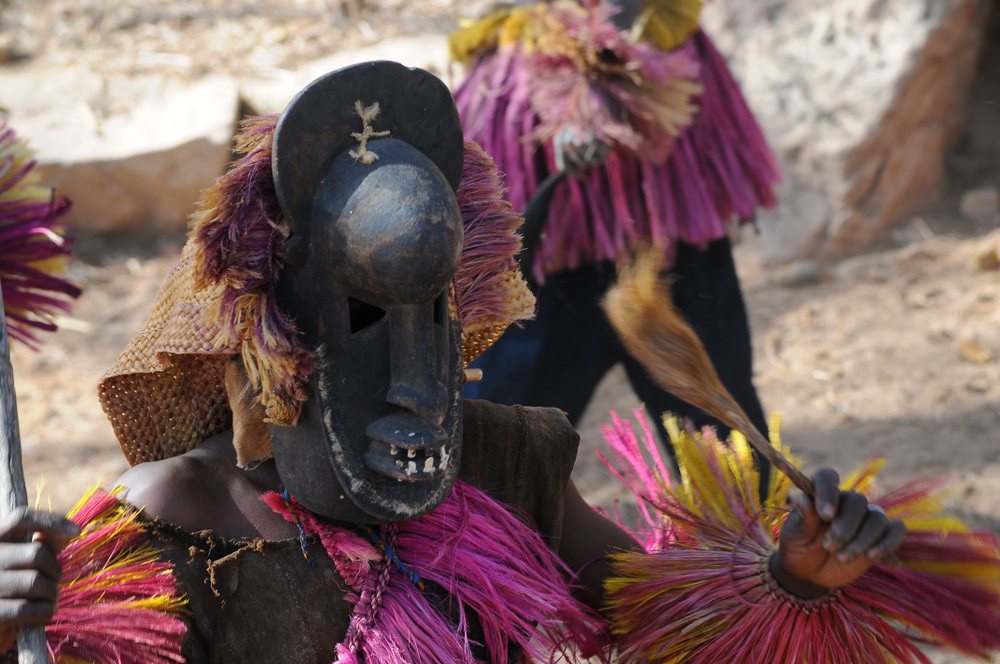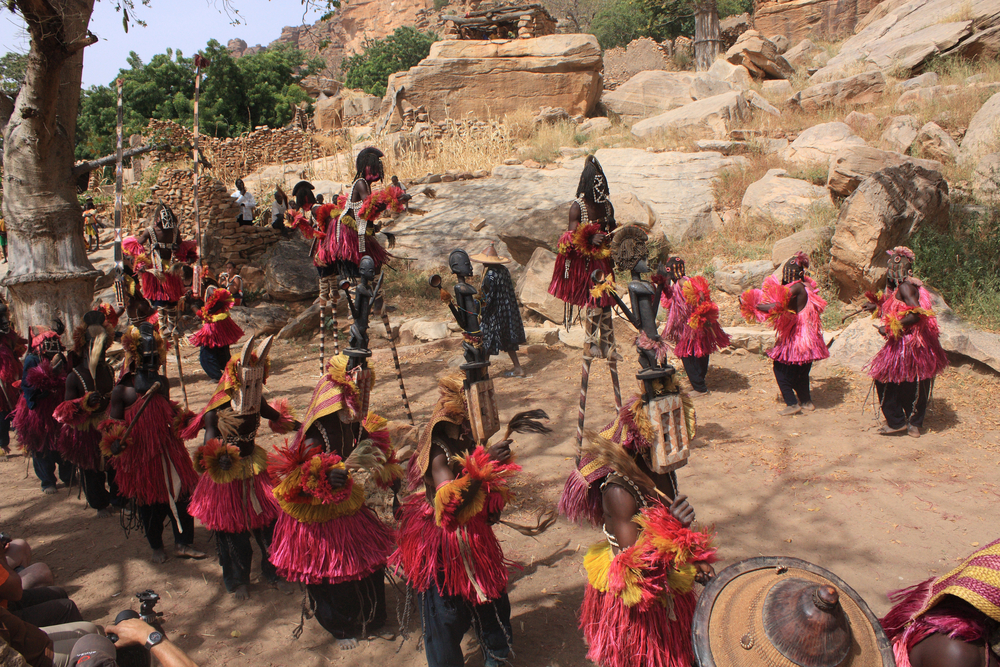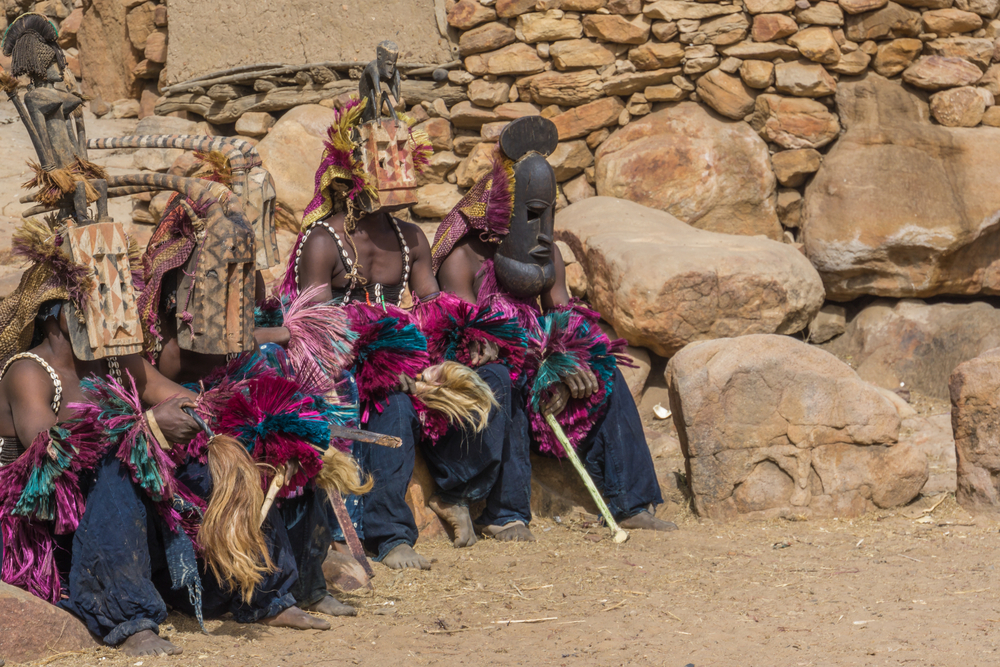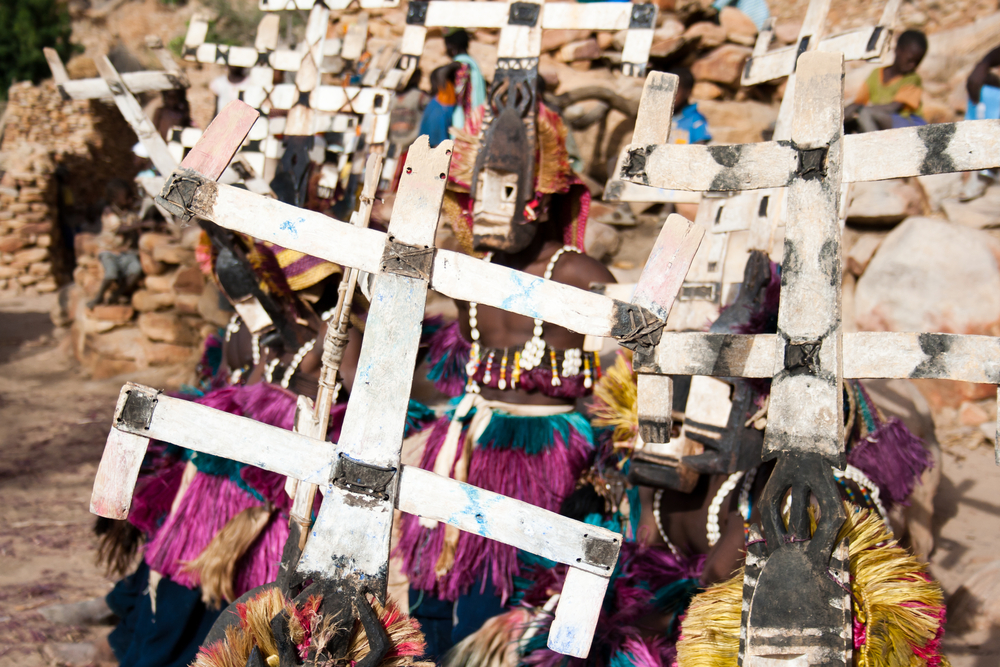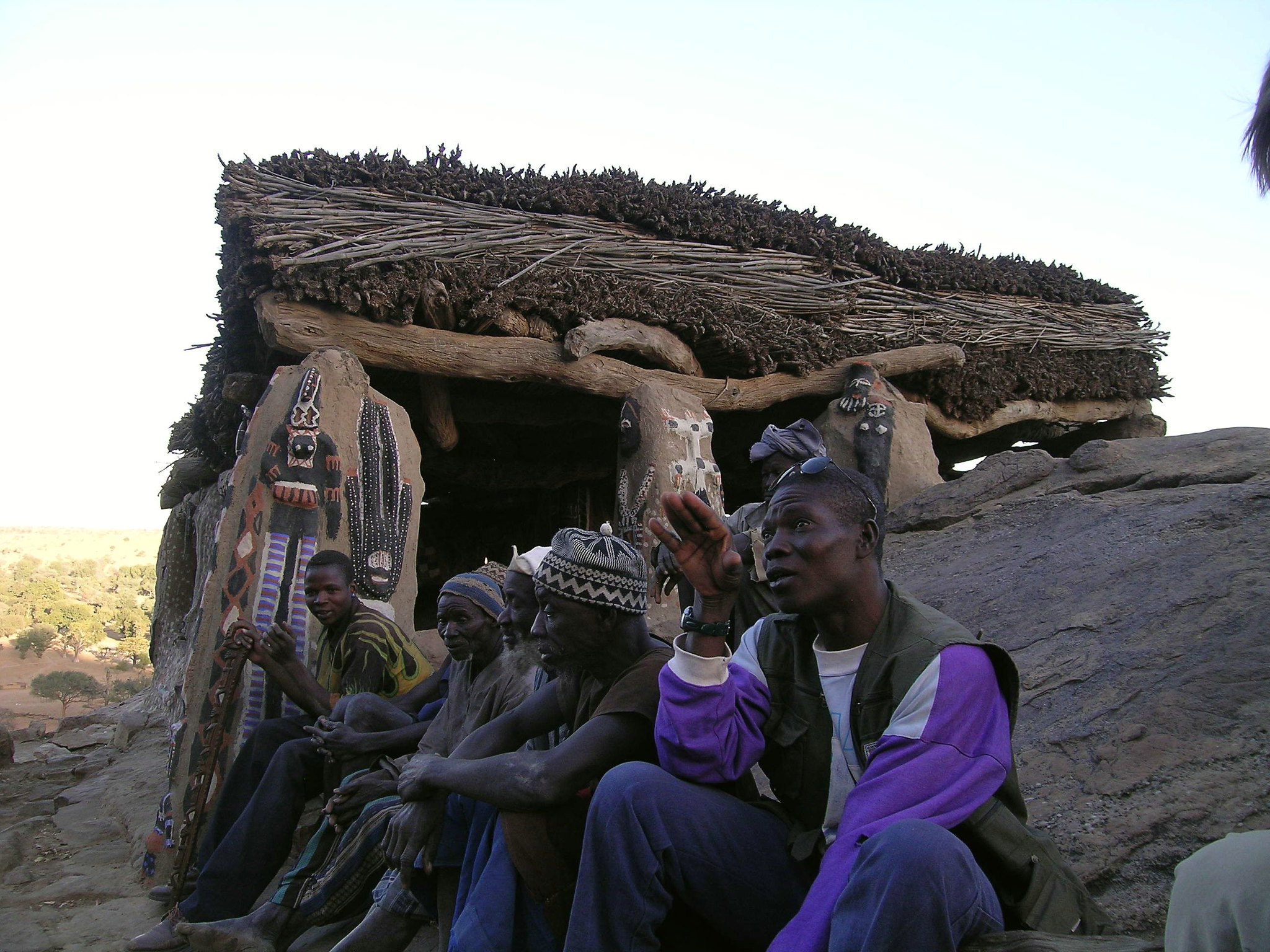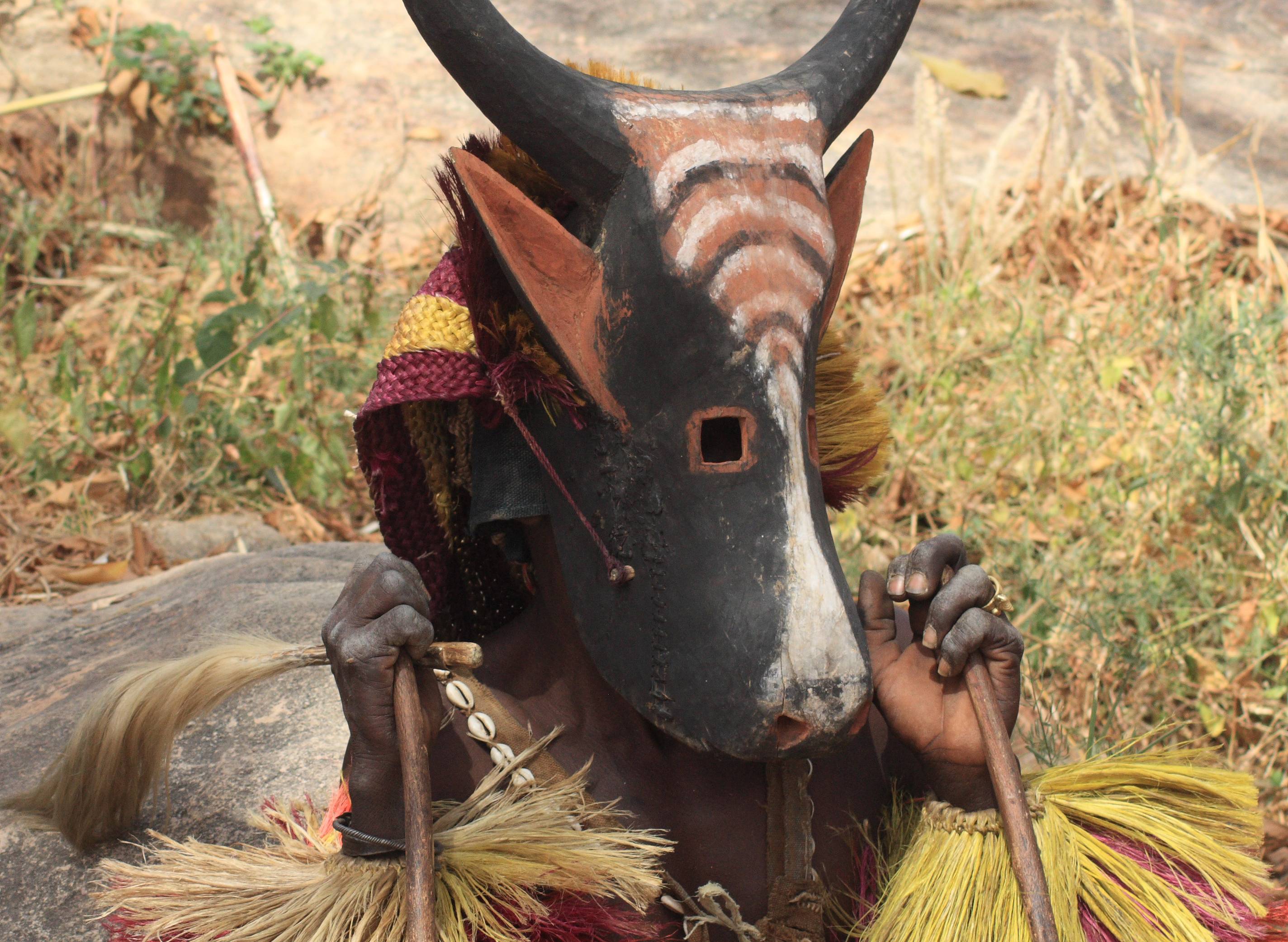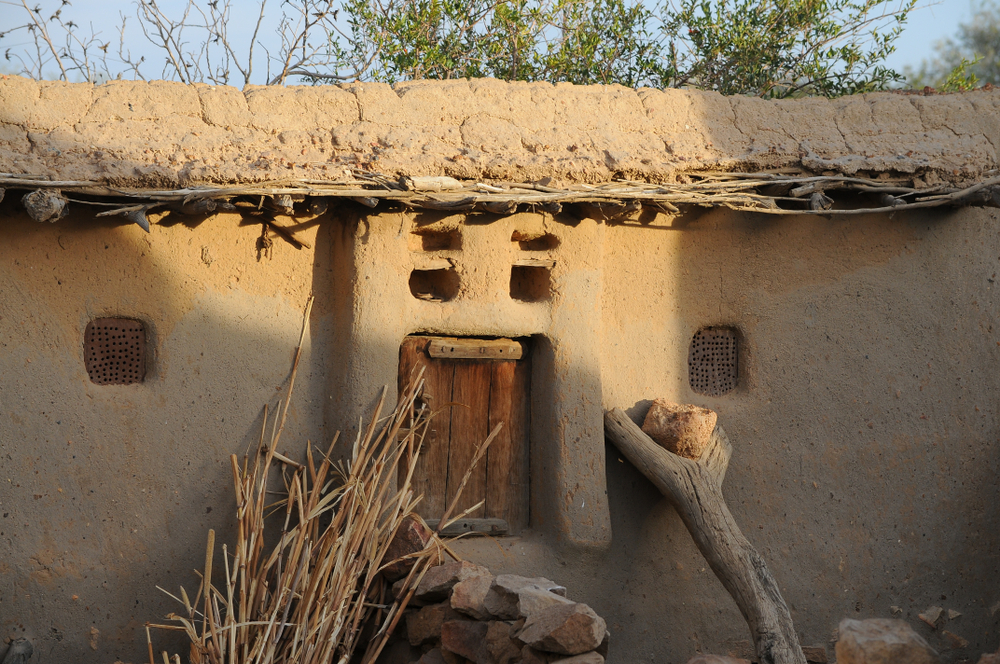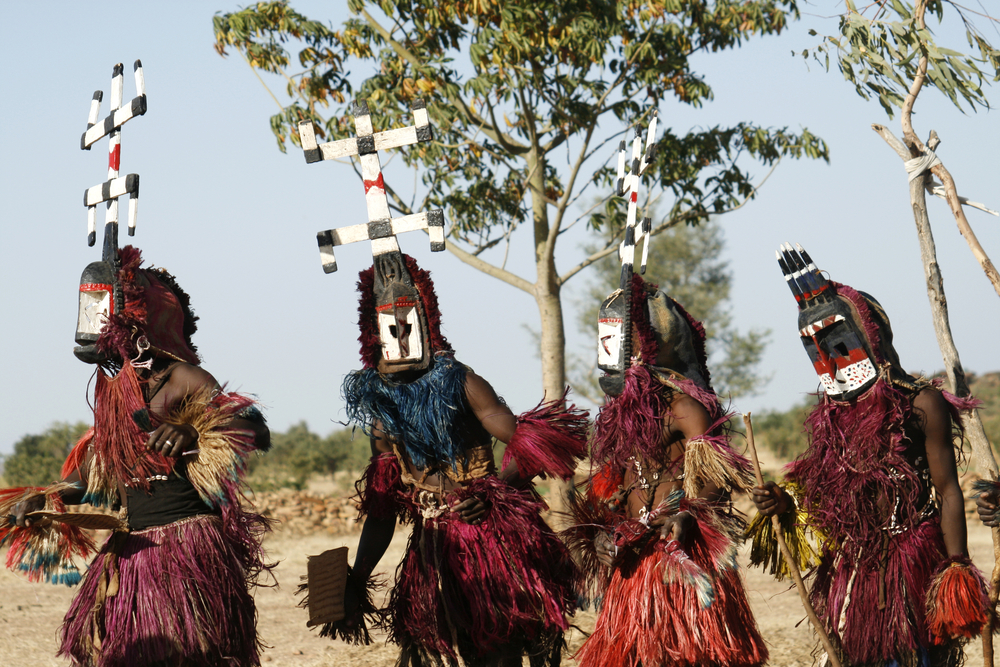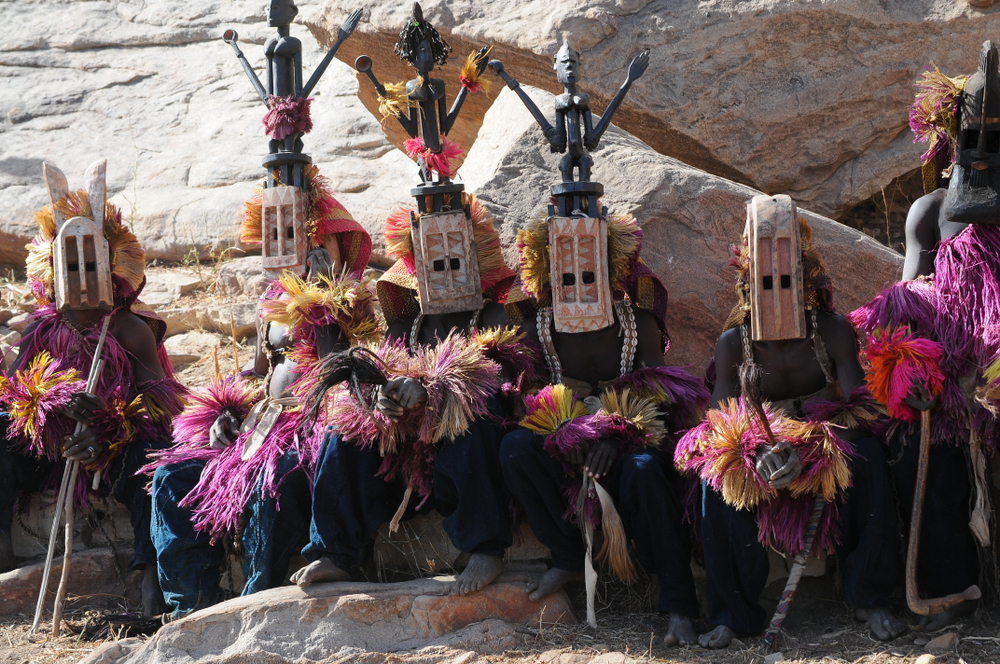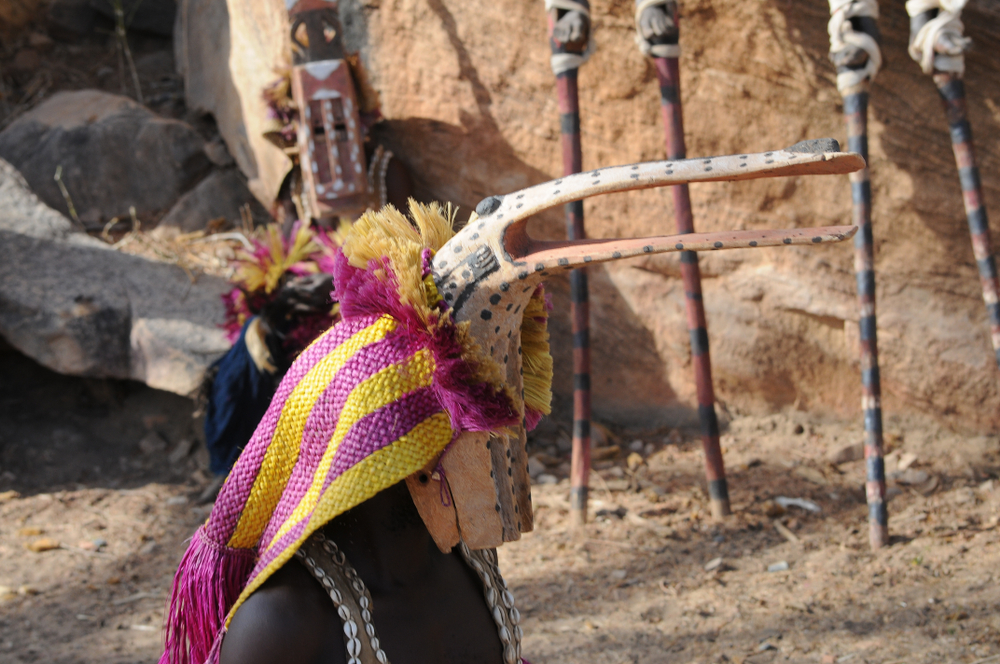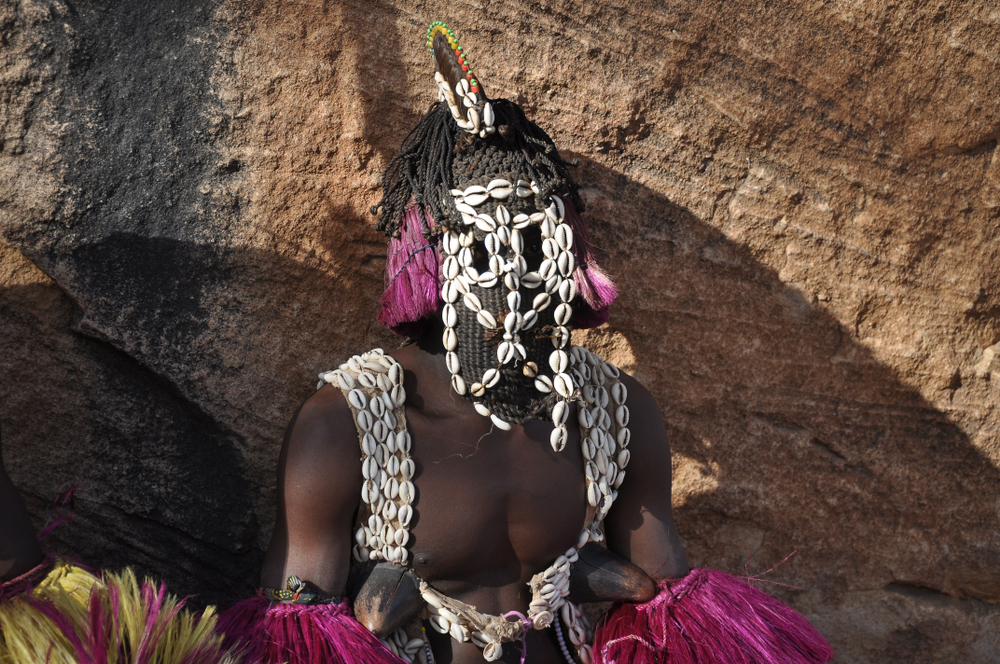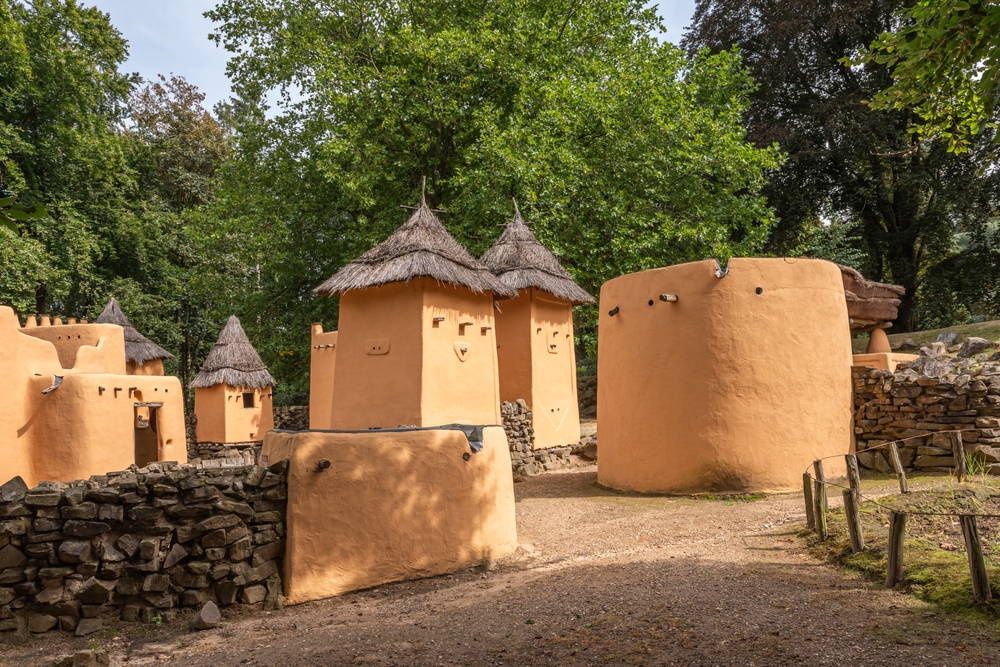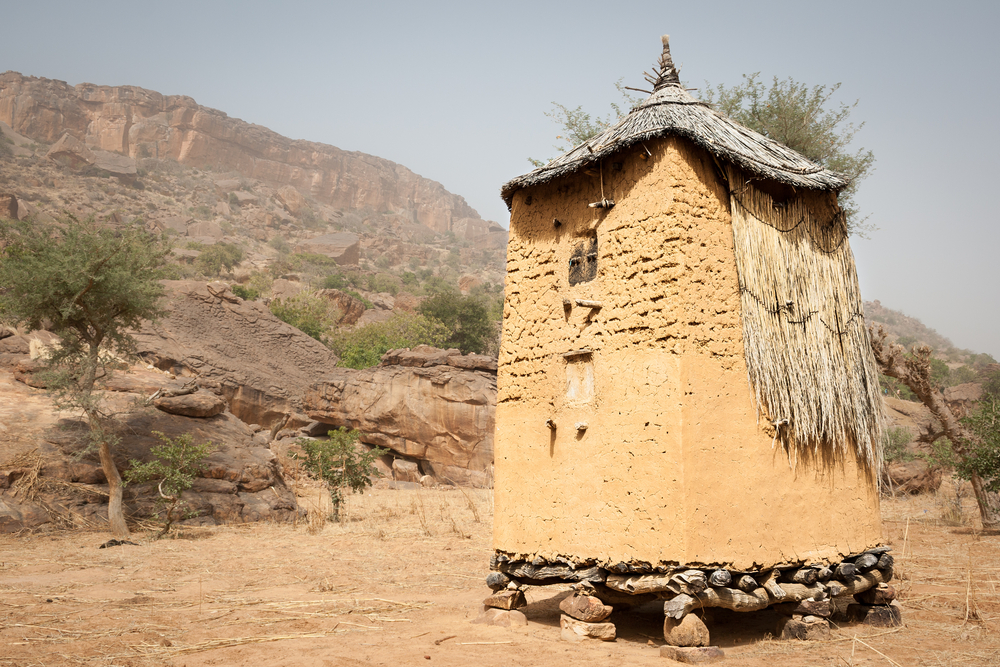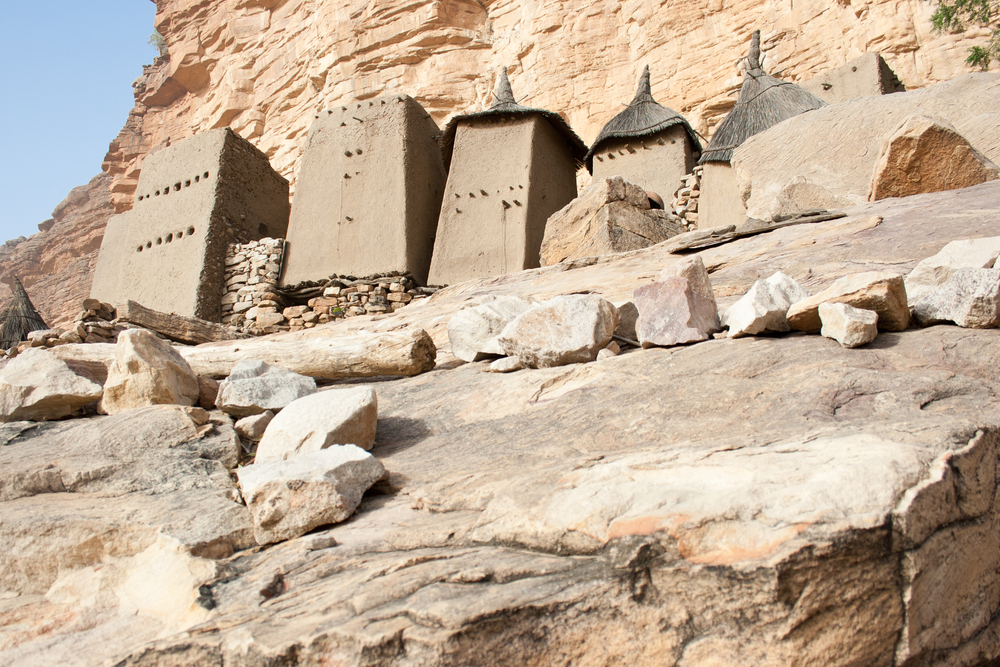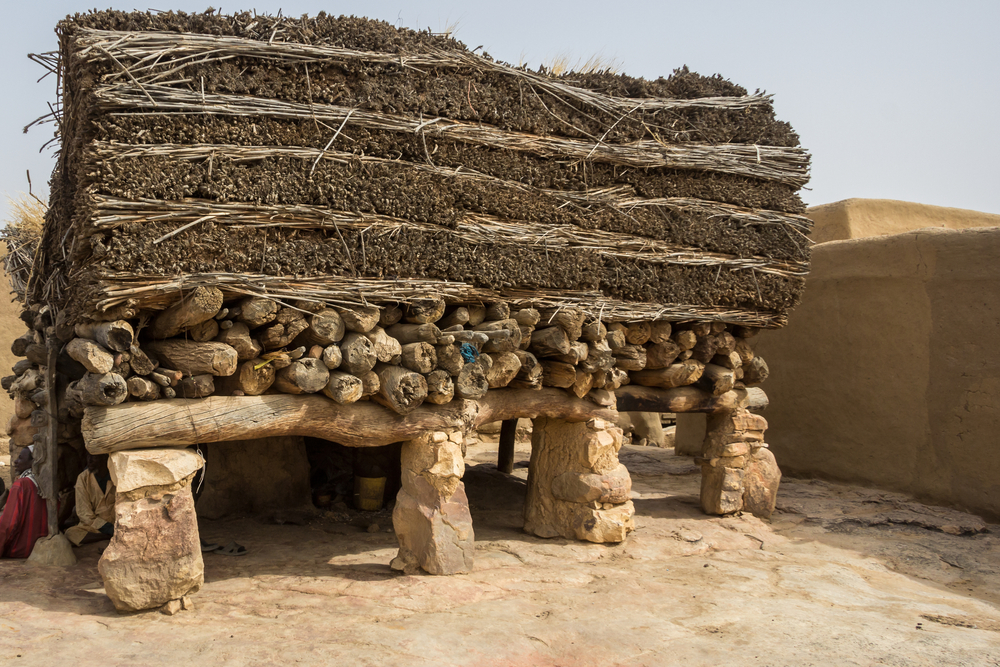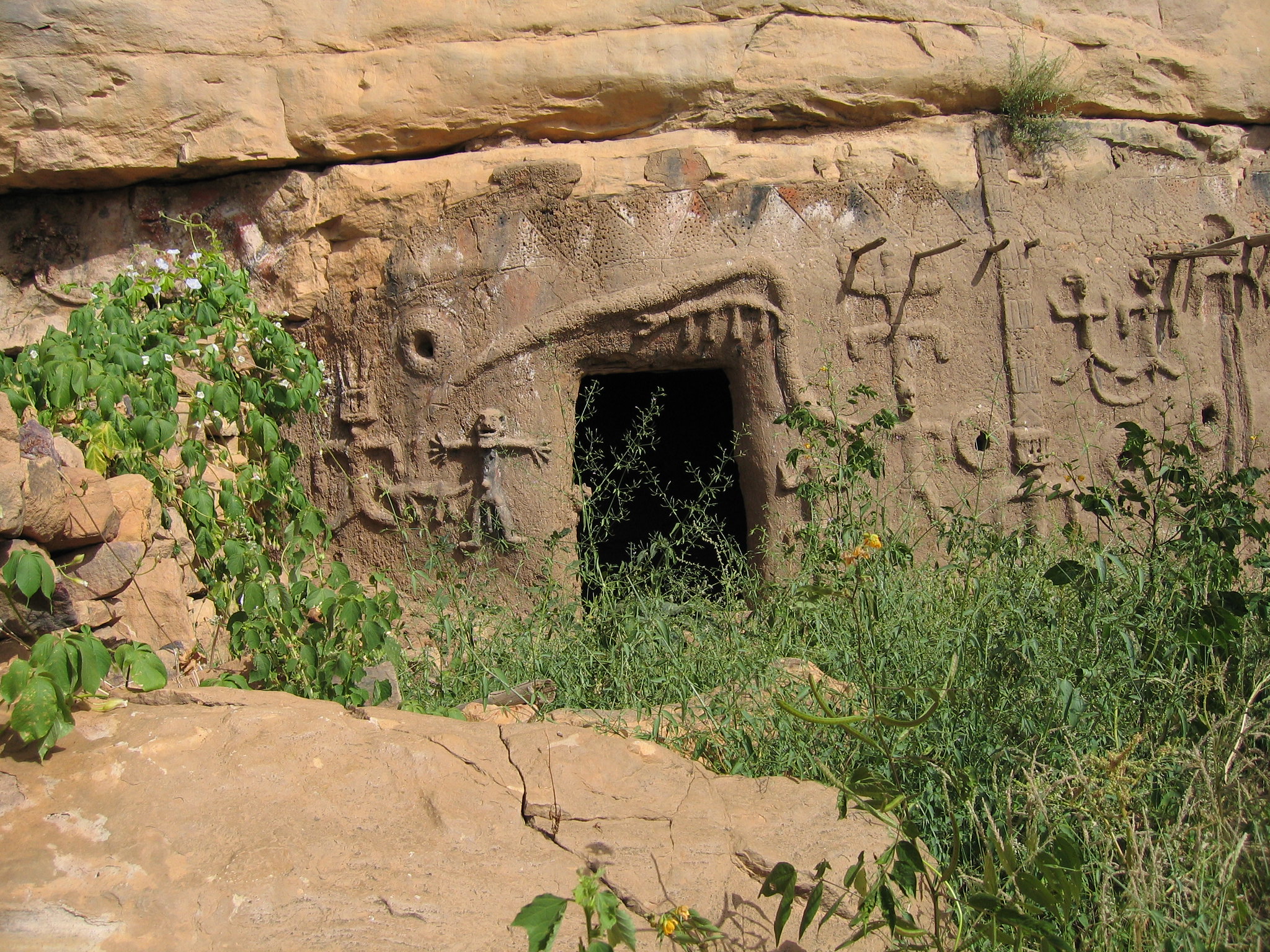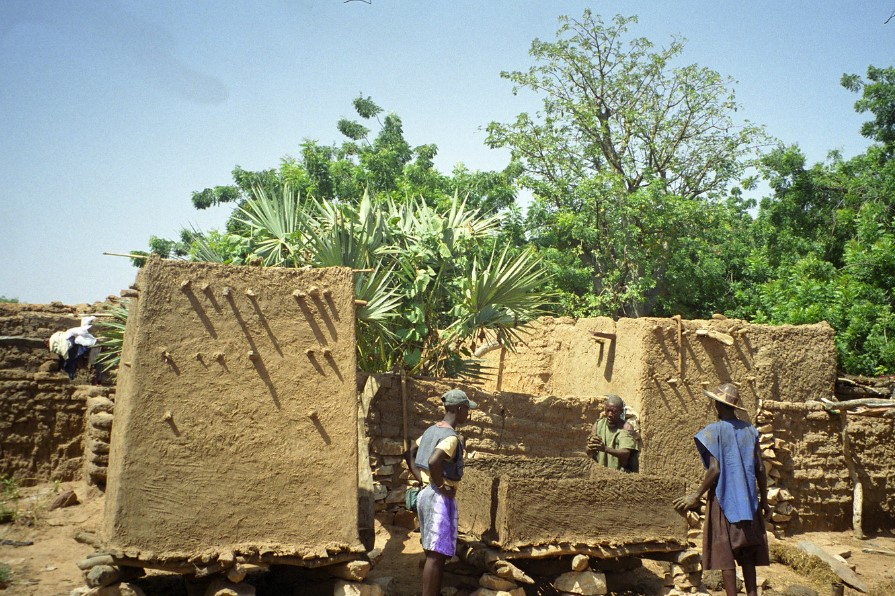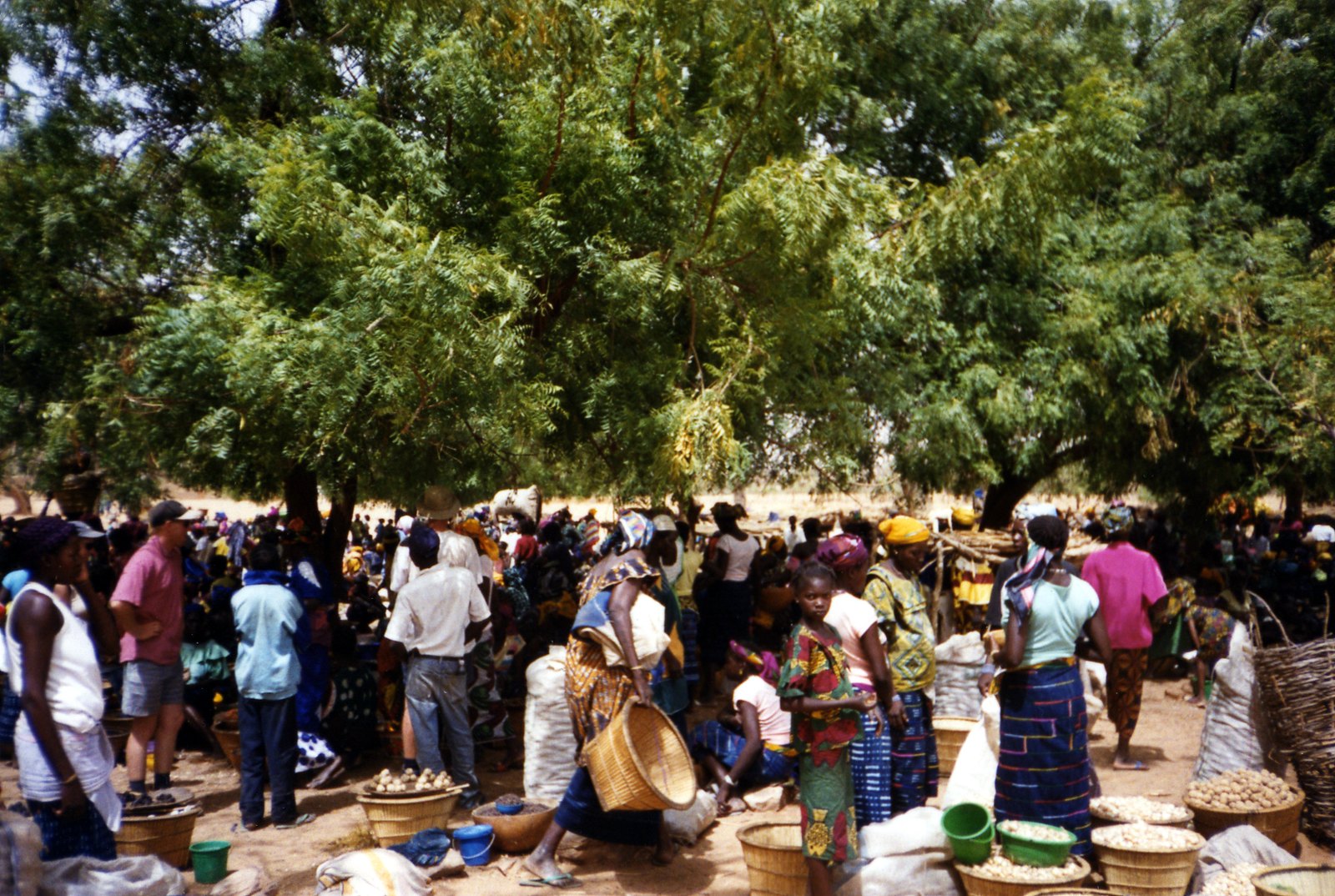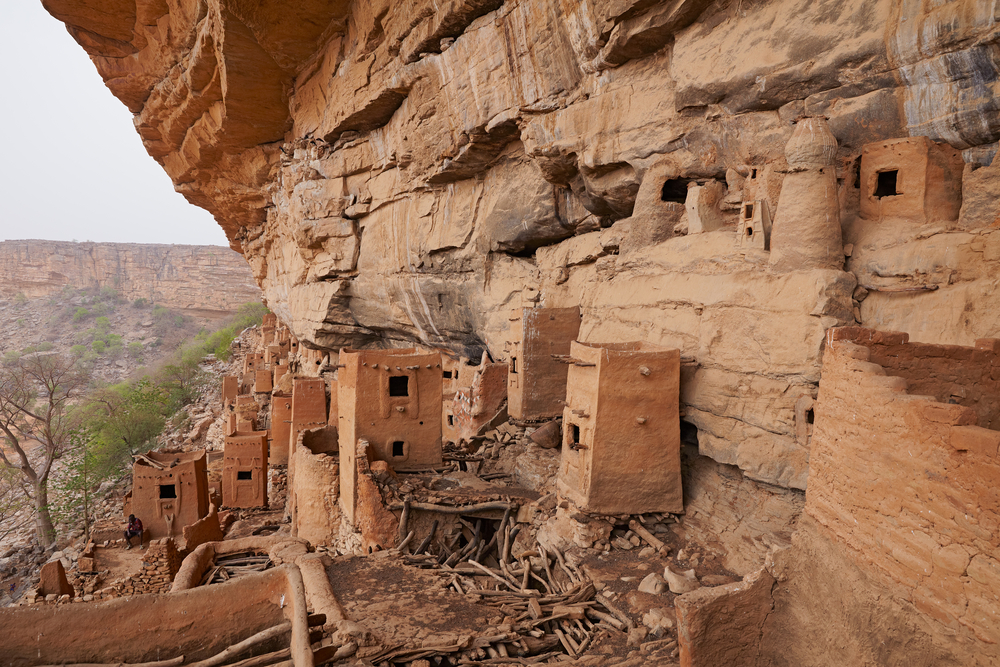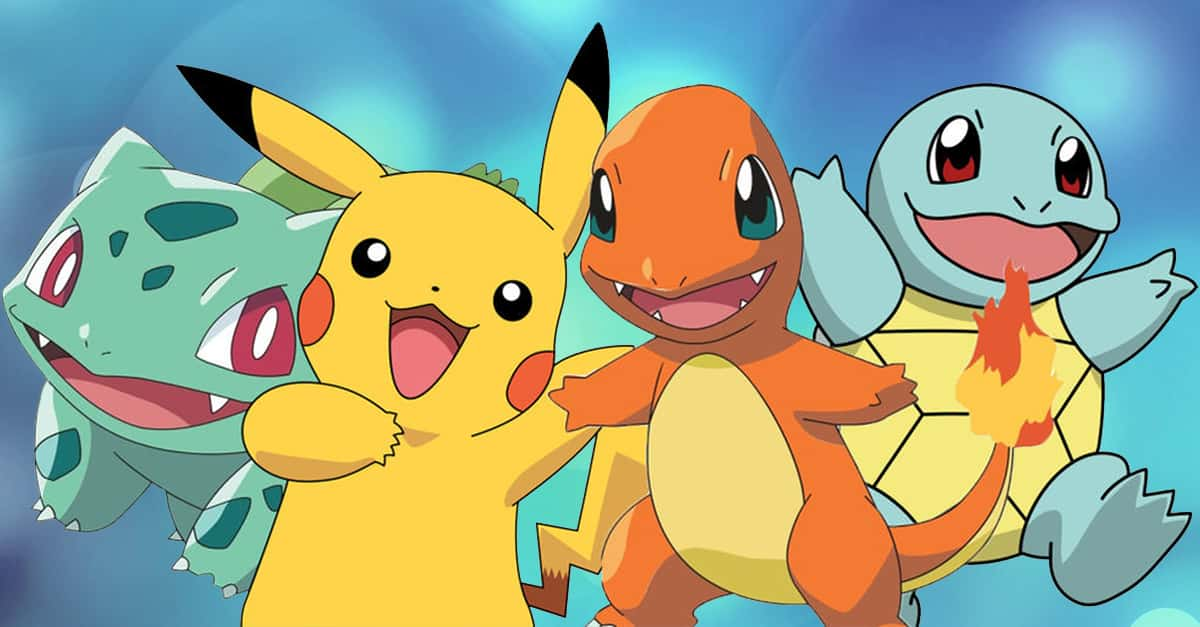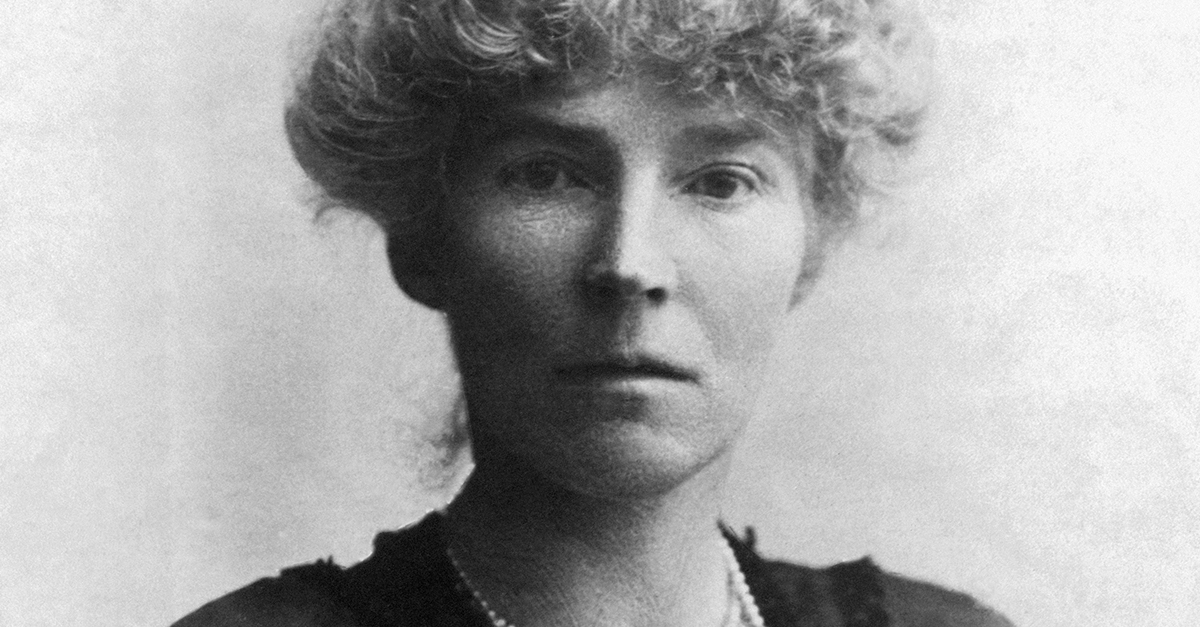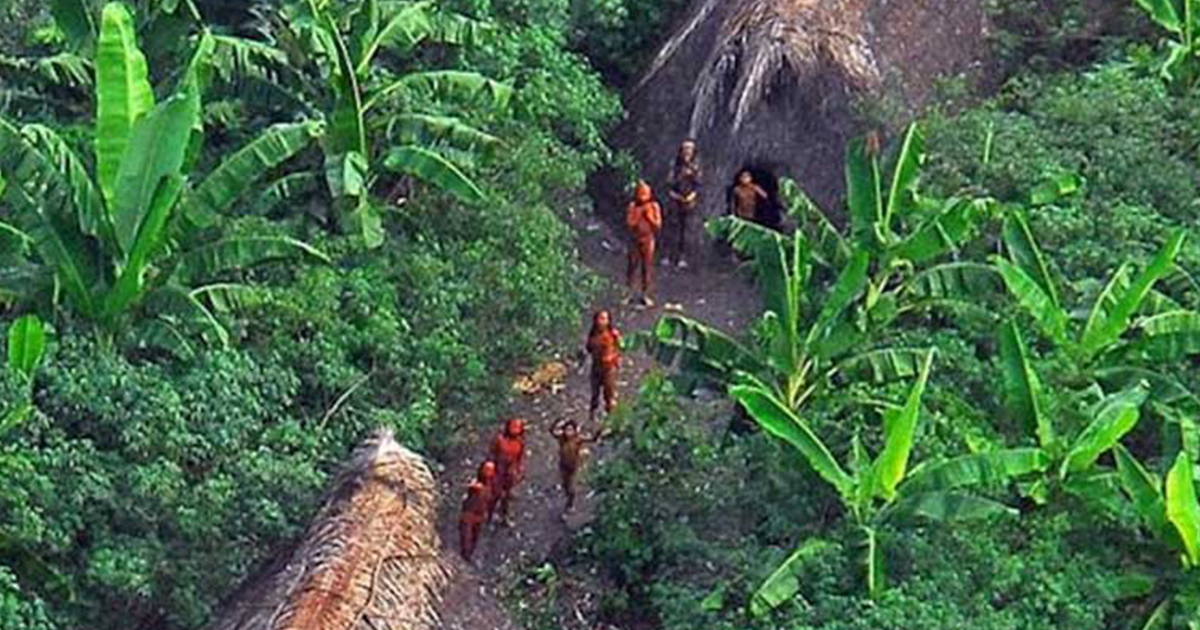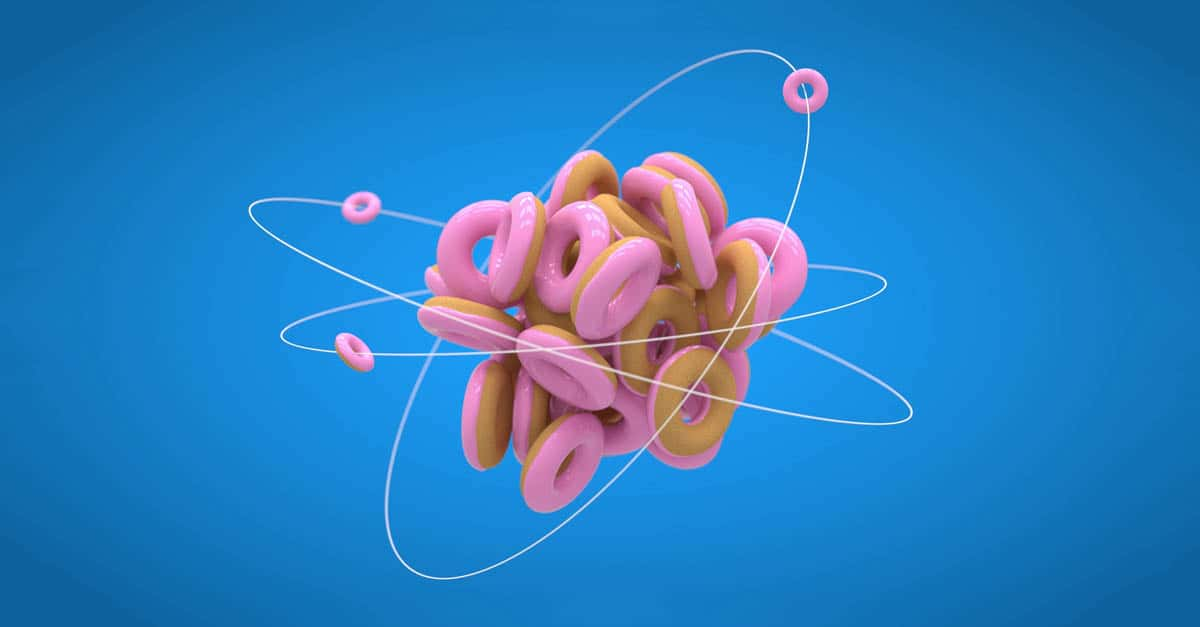Meet Mali’s Greatest Attraction
The colorful masks and religious ceremonies of the Dogon people have become a major draw for tourists from around the world.
But what’s really kept people talking about this tribe, is their intricate knowledge of astronomy—and the claim that they were once visited by aliens.

Where Do They Live?
It’s estimated that there are anywhere from 400,000 to 800,000 Dogon people living in the West African county of Mali.
Most Dogon live near the Bandiagara Escarpment and some also live in the city of Burkina Faso.
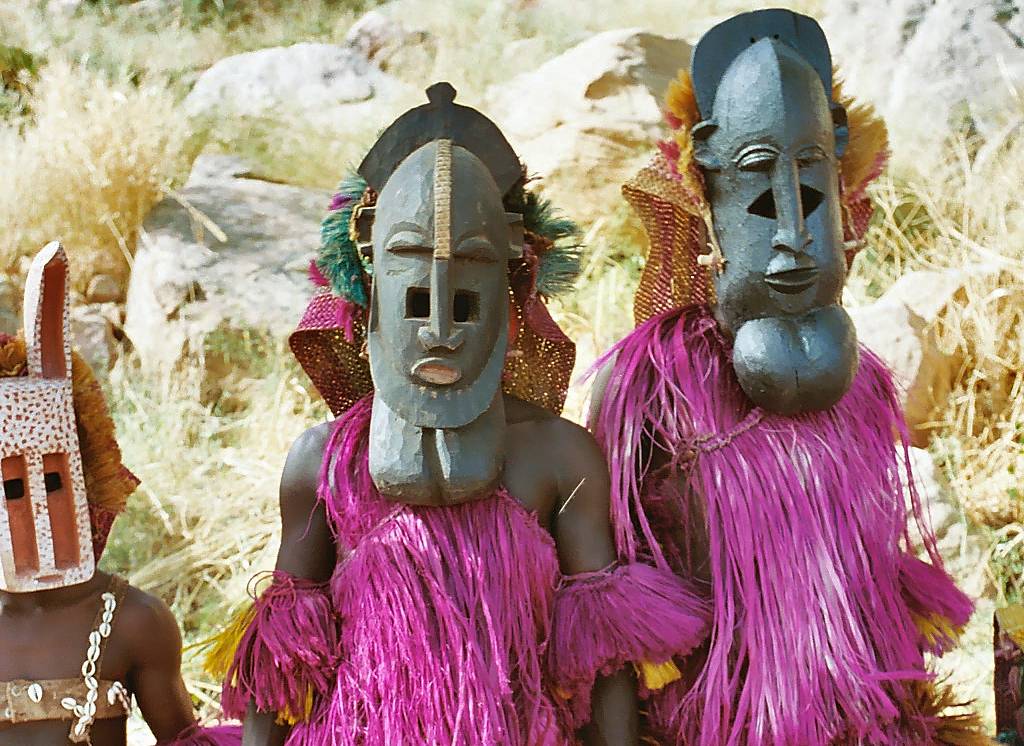 Devriese, CC BY 3.0 , Wikimedia Commons
Devriese, CC BY 3.0 , Wikimedia Commons
Where Do They Live? (cont’d)
The Bandiagara Escarpment is a sandstone cliff that rises 1,600 feet above sea level and stretches on for about 90 miles.
Thousands of years ago, the Dogon began building their villages in this area because they did not want to convert to Islam and needed to be able to defend themselves attackers.
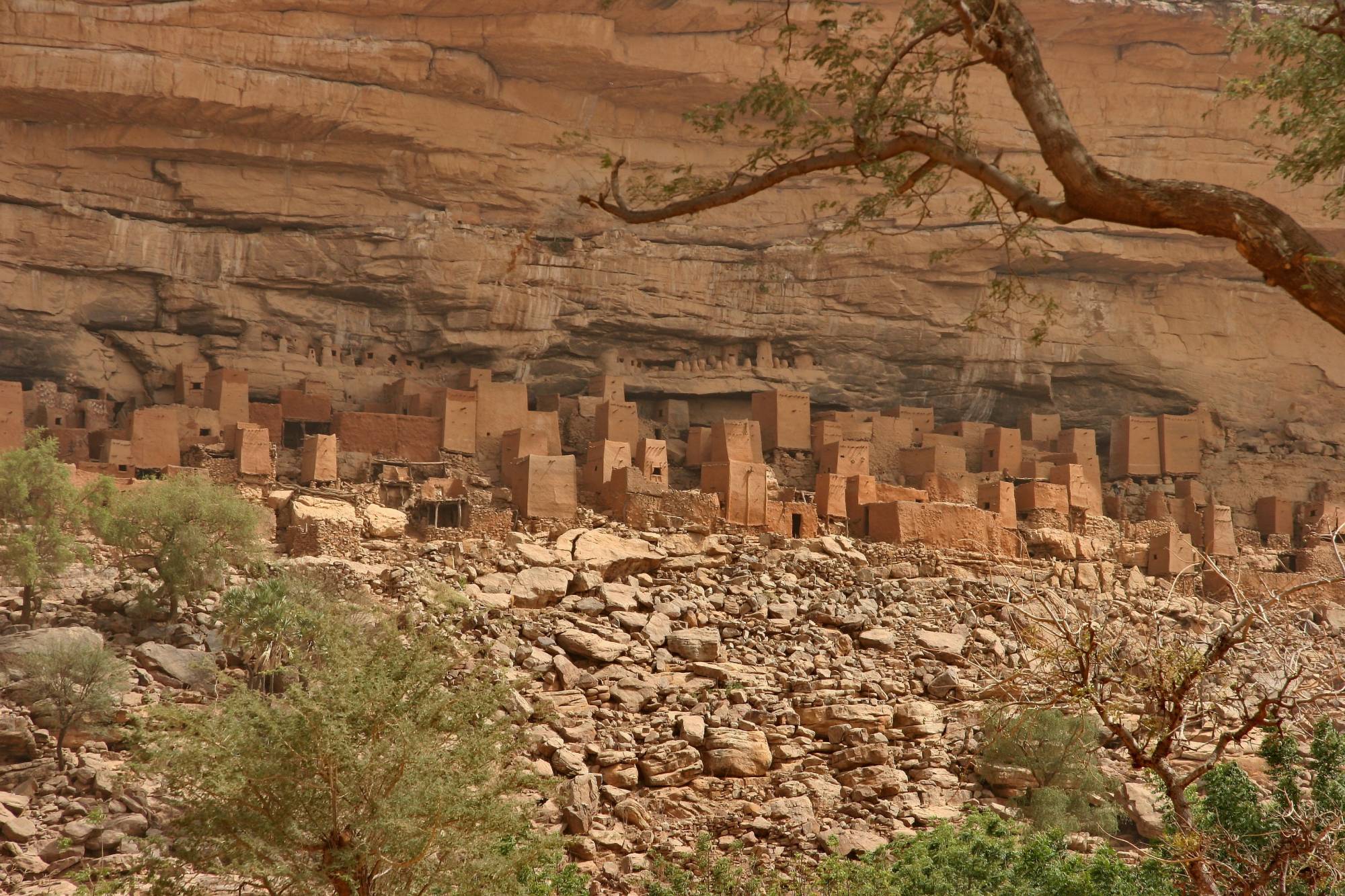 Ferdinand Reus, CC BY-SA 2.0, Wikimedia Commons
Ferdinand Reus, CC BY-SA 2.0, Wikimedia Commons
Falling On Tough Times
Under Islamic Law, the Dogon and many other Indigenous people like the Yoruba and Mossi, were treated as second-class citizens.
Slave raids against their communities were frequent, and the demand for Dogon slaves increased as cities grew.
They Ran Away
For 1,000 years, the Dogon were persecuted. Many retreated high into Bandiagara Escarpment, hiding their villages in defensible nooks and crannies in the cliff.
While many still practiced their traditional religion, the influence of Islam—and later, Christianity—was unavoidable. Today, about 35% of Dogon people identify as Muslim, while 10% are Christian.
Knowledge Of The Stars
When the Dogon met French anthropologists in the 1930s, they amazed the anthropologists with their knowledge of astronomy.
The Dogon had their own calendrical measurements and methods of calculation. They also had extensive astronomical knowledge, especially about the Sirius star system.
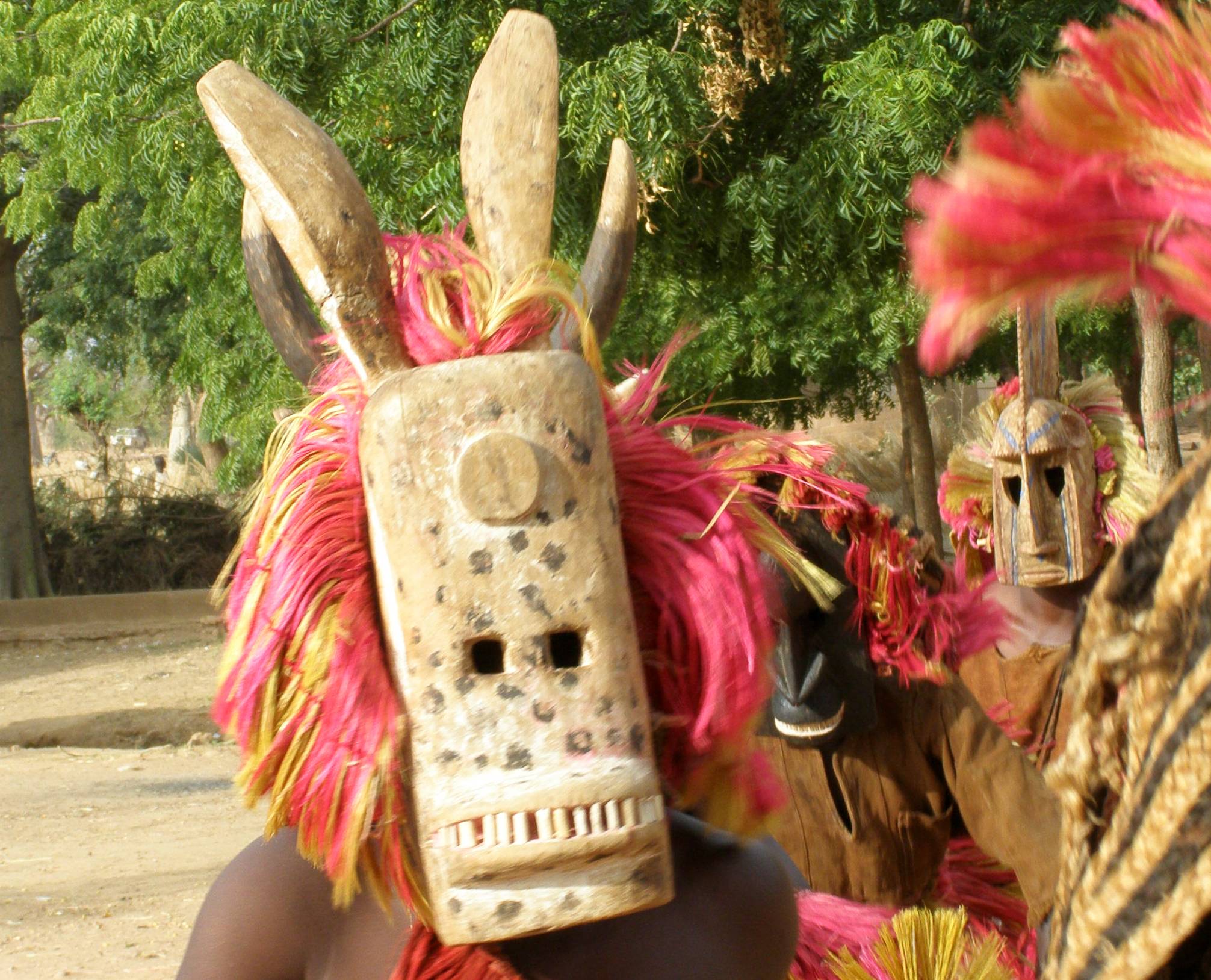 BluesyPete, CC BY-SA 3.0, Wikimedia Commons
BluesyPete, CC BY-SA 3.0, Wikimedia Commons
Knowledge Of The Stars (cont’d)
The Dogon believed in the existence of the moons of Jupiter and the ring of Saturn, which was unheard of because they couldn’t see these planets without a telescope. They also knew about Sirius B, a dwarf star that’s invisible to the naked eye.
To this day, we still don’t know how they knew about these planetary aspects—but if the Dogon themselves are to be believed, this knowledge was an extraterrestrial gift.
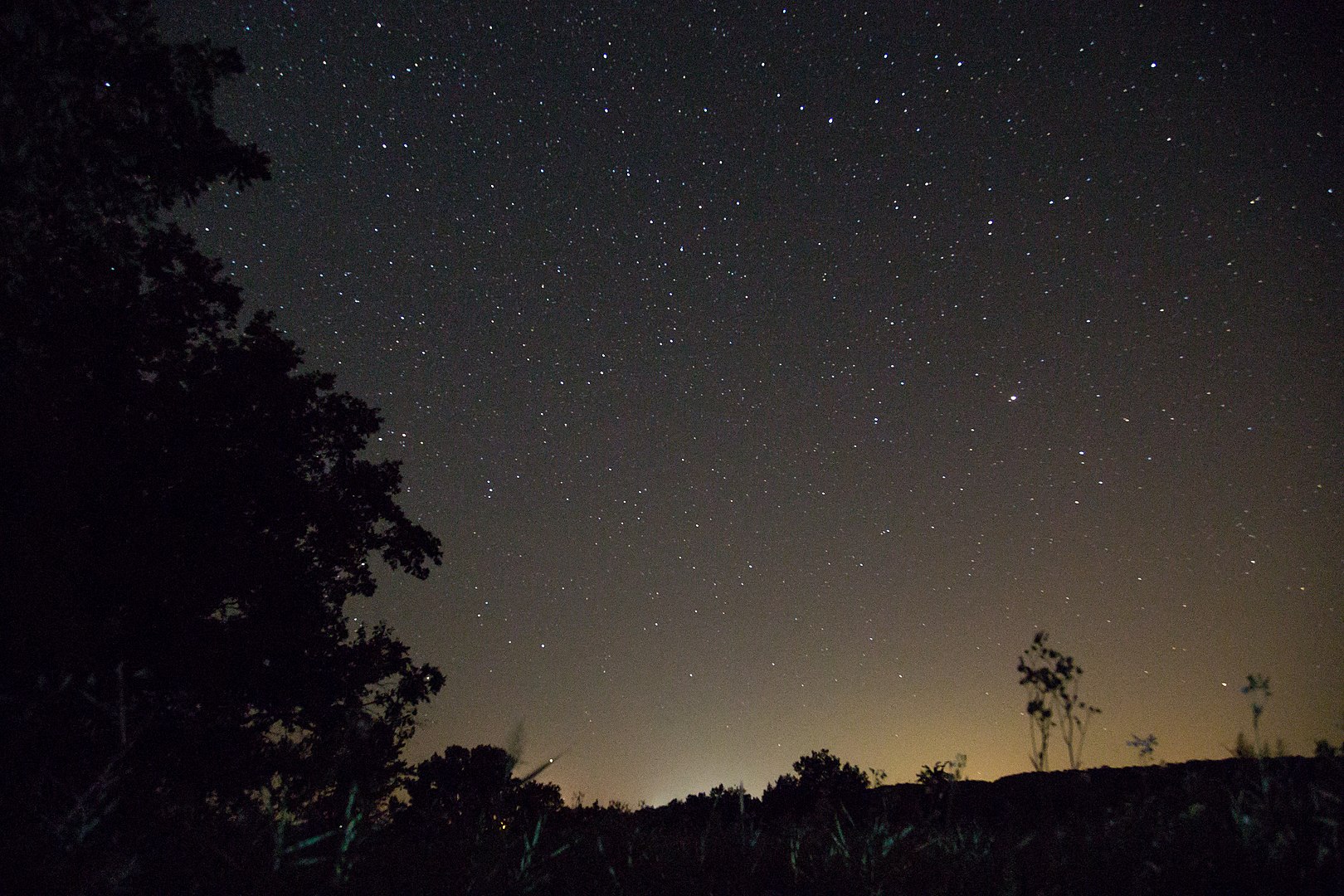 Alexey Elfimov, CC BY 3.0 , Wikimedia Commons
Alexey Elfimov, CC BY 3.0 , Wikimedia Commons
The Nummo Twins
The Nummo twins are the main divine beings in Dogon spirituality. According to Dogon myths, the Nummo twins came from the Sirius star system.
The Nummo twins were amphibian-like creatures who looked like snakes from below the waist and humans from the waist up. They also had green skin and hair, red eyes, and forked tongues. Definitely sounds like aliens to me.
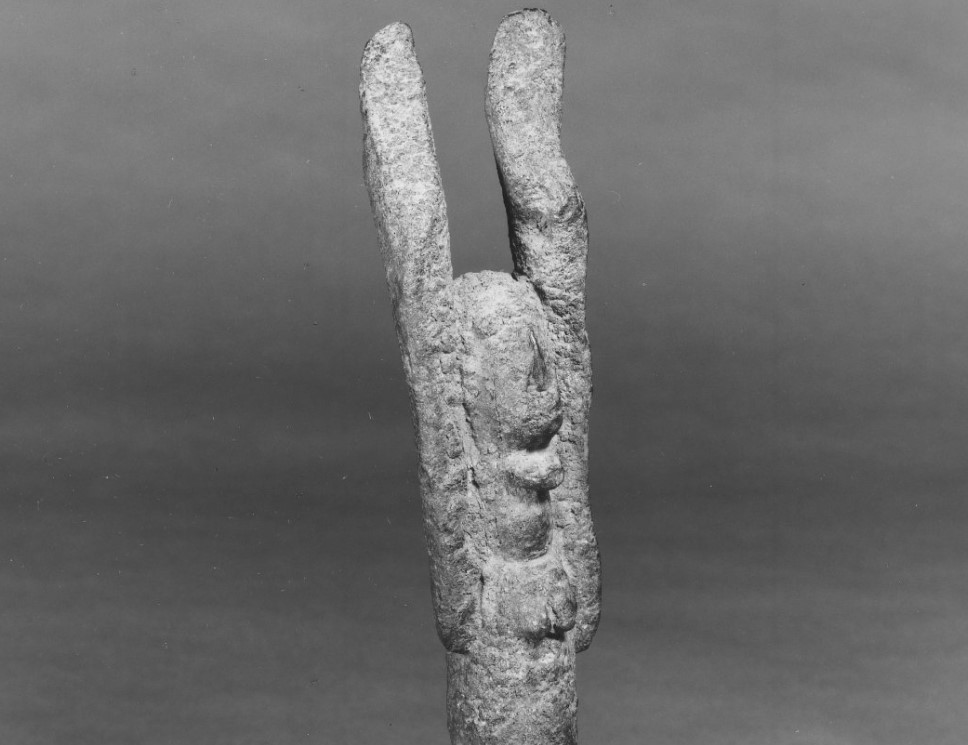 Brooklyn Museum, CC BY 3.0, Wikimedia Commons
Brooklyn Museum, CC BY 3.0, Wikimedia Commons
Extraterrestrial Teachers
The Dogon claim that the Nummo twins taught them about the Sirius star system. They even say there is a third star in the Sirius system.
The crazy thing is, they might be right—gravitational observations support the presence of a third star, though we’ve yet to actually see it.
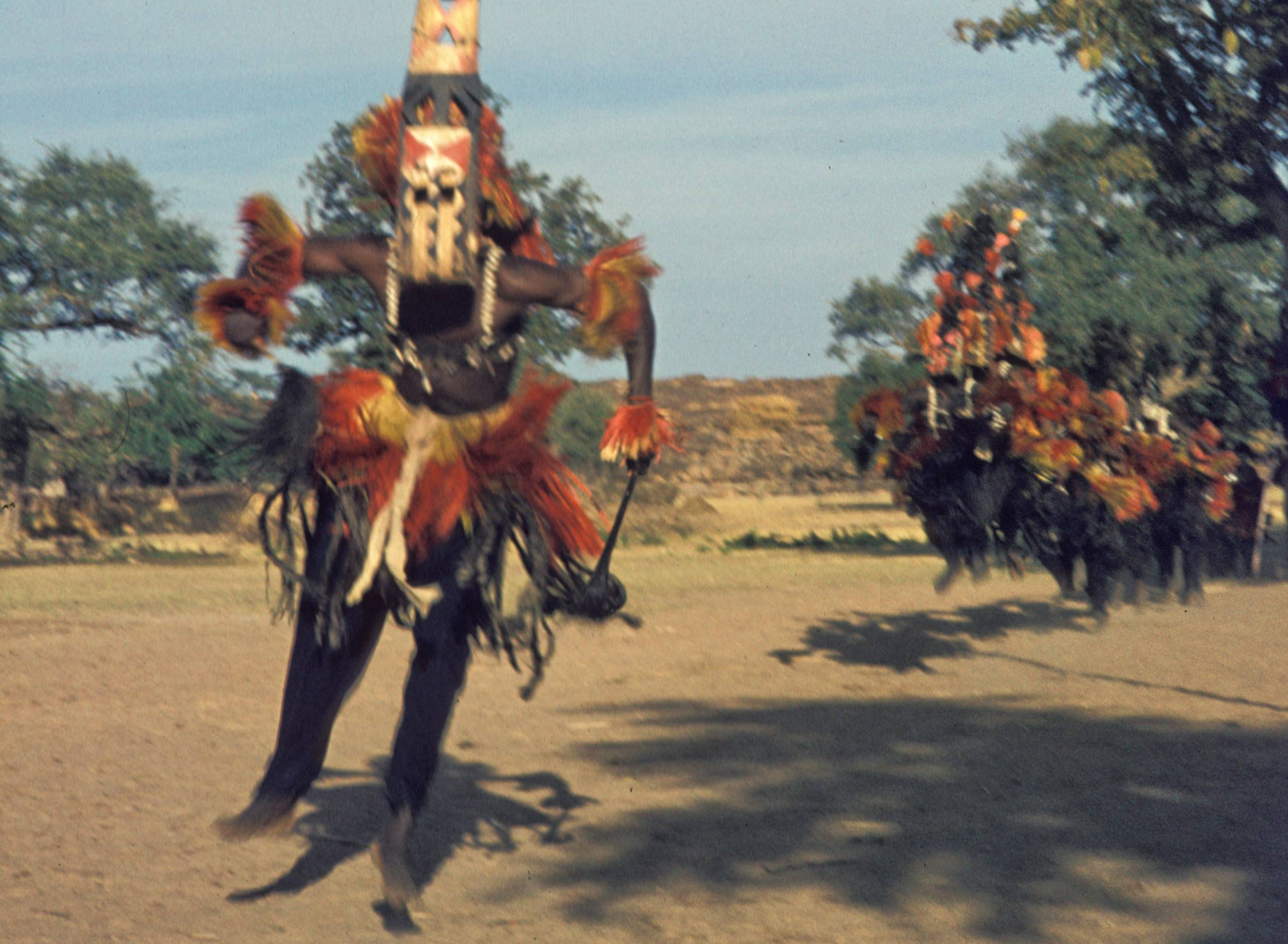 H. Grobe, CC BY-SA 3.0 , Wikimedia Commons
H. Grobe, CC BY-SA 3.0 , Wikimedia Commons
Ancient Knowledge
Some people have suggested that since the Dogon didn’t know about other planets in the solar system, they were just reiterating knowledge that they got from the French anthropologists.
However, this theory has been largely debunked, as artifacts and oral histories show that the Dogon knew about these planets hundreds of years before contact with the anthropologists.
So How Did They Know?
It’s still unclear how the Dogon knew such detailed astrological information. Maybe they really were visited by aliens.
Another, less exciting theory is that the Dogon spent thousands of years observing the stars and passed down all that detailed information through their oral traditions.
Sacred Twins
Twins are an important part of the traditional Dogon religion. The Dogon believe that people used to be born with a twin, but something went wrong in the divine order that caused subsequent generations to be born alone.
Many Dogon mourn the loss of their twin and even claim to be haunted by them.
Celebrating Twins
Because twins are so important in Dogon spirituality, the birth of twins is often a cause for celebration in the village.
Human twins are reminders of the Dogon’s ancestors and are thought to be symbols of the connection between humanity and the divine.
The Creator God
In addition to the Nummo twins, many Dogon also believe in the god Amma. Amma is said to have created the earth and shaped it with curves like a woman to fill it with divine feminine energy.
Dogon Marriage
Most Dogon are monogamous, but there are some cases of polygamy for men.
Typically, polygamous men only have two wives, and each wife has her own house on the husband’s compound. The first wife holds a higher position of respect than the others.
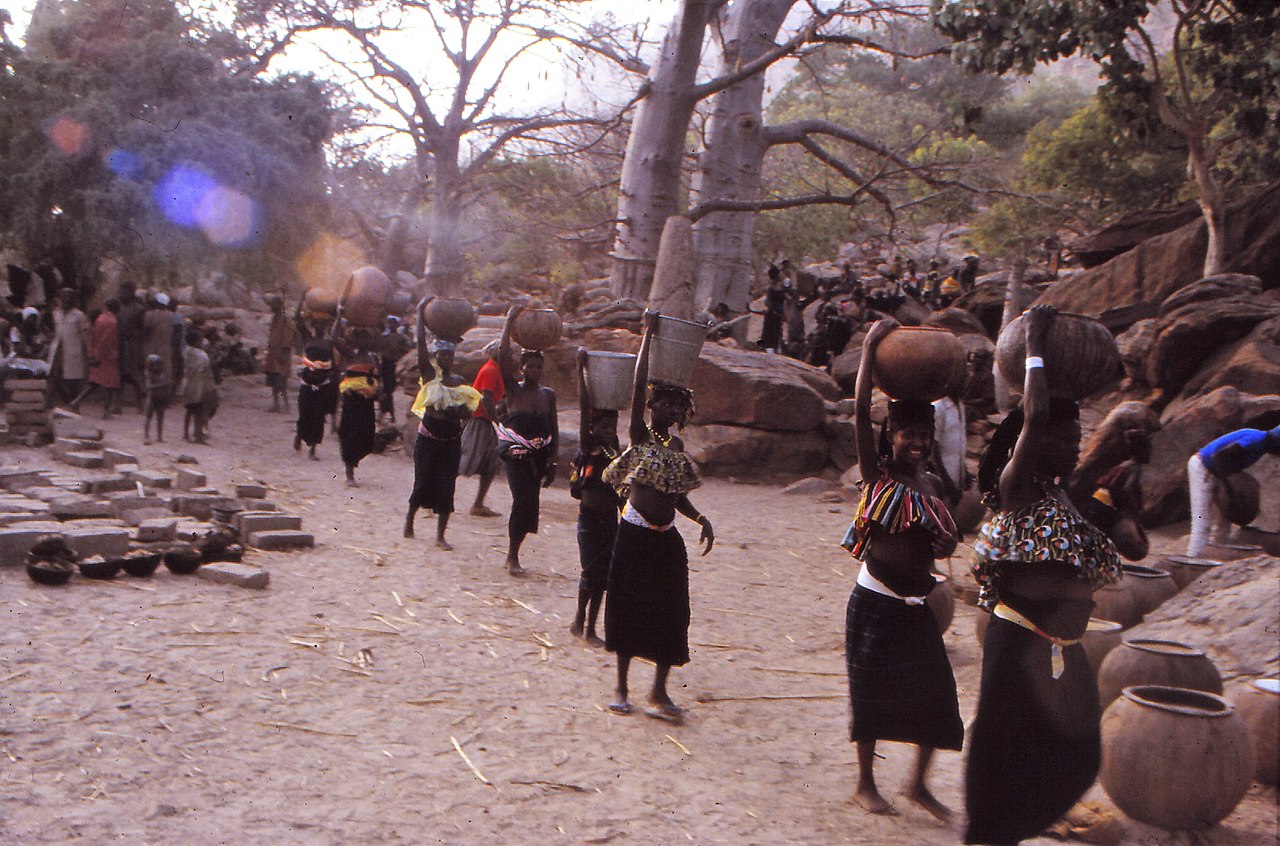 W.E.A. van Beek, CC BY-SA 4.0 , Wikimedia Commons
W.E.A. van Beek, CC BY-SA 4.0 , Wikimedia Commons
Dogon Marriage (cont’d)
Dogon can only marry people from within their clan and caste. A man’s parents usually choose his bride, and she officially moves into his house after giving birth to their first child.
Divorce In Dogon Communities
Divorce is very serious for the Dogon. Before the birth of the couple’s first child, women can leave their husbands, but once the couple has children, divorce is rarely an option.
However, despite the rarity, divorce does happen more often with polygamous marriages. If a couple parts ways, the woman can the take the youngest child with her but must leave all the rest with her ex-husband.
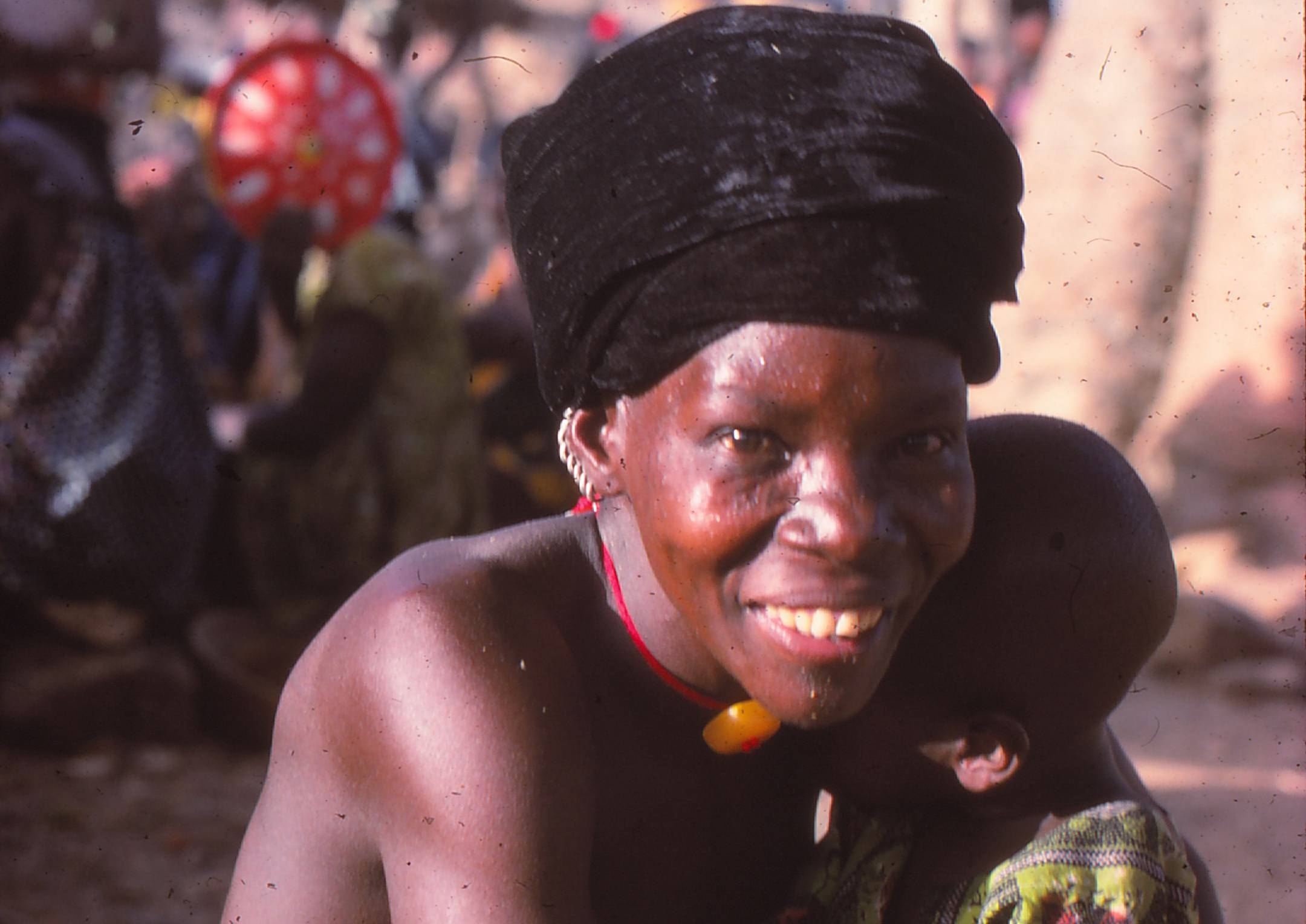 W.E.A. van Beek, CC BY-SA 4.0, Wikimedia Commons
W.E.A. van Beek, CC BY-SA 4.0, Wikimedia Commons
Peaceful People
The Dogon place strong value on living in harmony, and this is reflected in their rituals.
For example, one the Dogon’s most important rituals involves the women praising the men, the men thanking the women, the youth expressing appreciation for the elders, and the elders acknowledging the contributions of the youth.
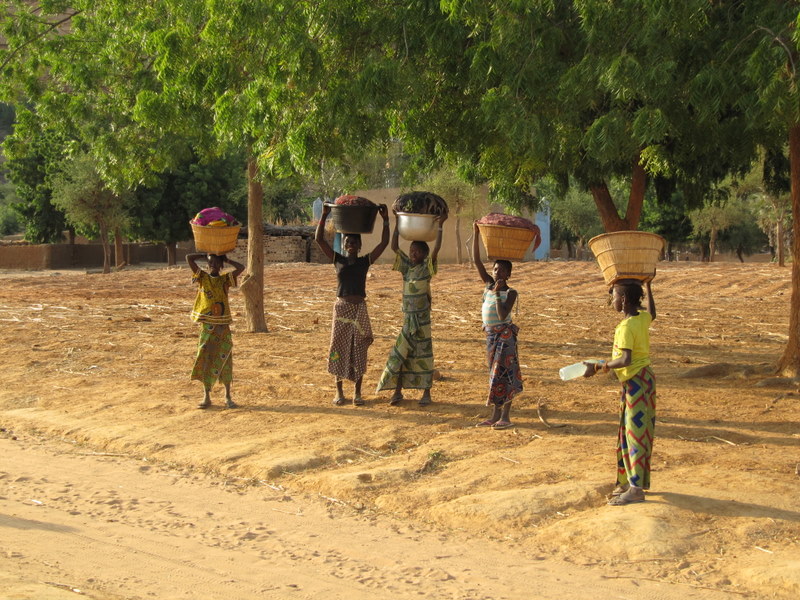 Martijn.Munneke , CC BY 2.0 , Wikimedia Commons
Martijn.Munneke , CC BY 2.0 , Wikimedia Commons
The “Sewa” People
The Dogon also have a famous greeting ritual, in which people ask and answer a series of questions about themselves or their family.
After being asked about their wellbeing, people usually respond with “sewa”, which means “everything is fine”, and then proceed to ask the other person the same questions.
Because everyone uses this greeting and sewa is said so often in Dogon villages, neighboring tribes have nicknamed the Dogon the sewa people.
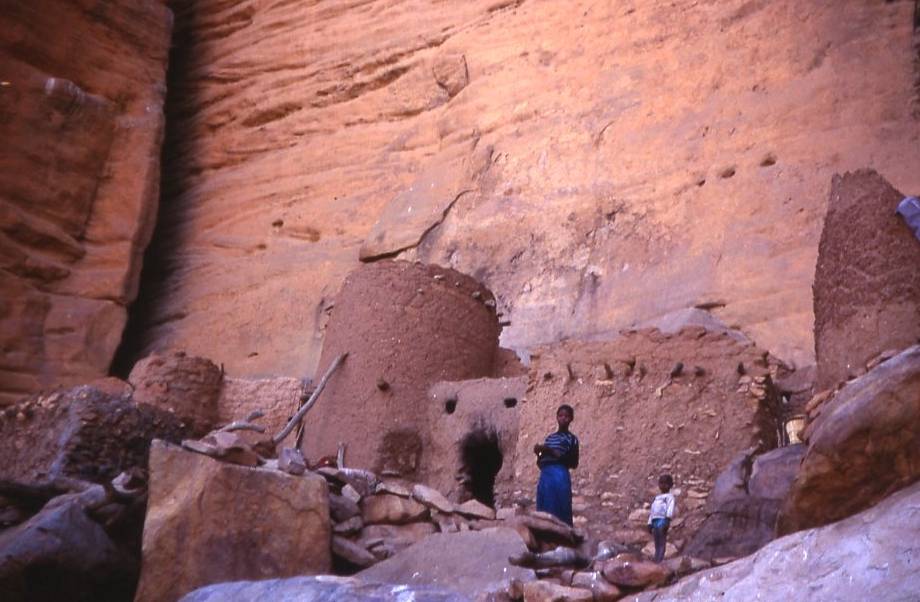 Jeanne Menjoulet, CC BY 2.0 , Wikimedia Commons
Jeanne Menjoulet, CC BY 2.0 , Wikimedia Commons
The Hogon
The Hogon is the most respected person in a Dogon village. He is the political and spiritual leader, and is elected from elders who have strong lineages in the village.
After being elected, the Hogon must go through a six-month initiation.
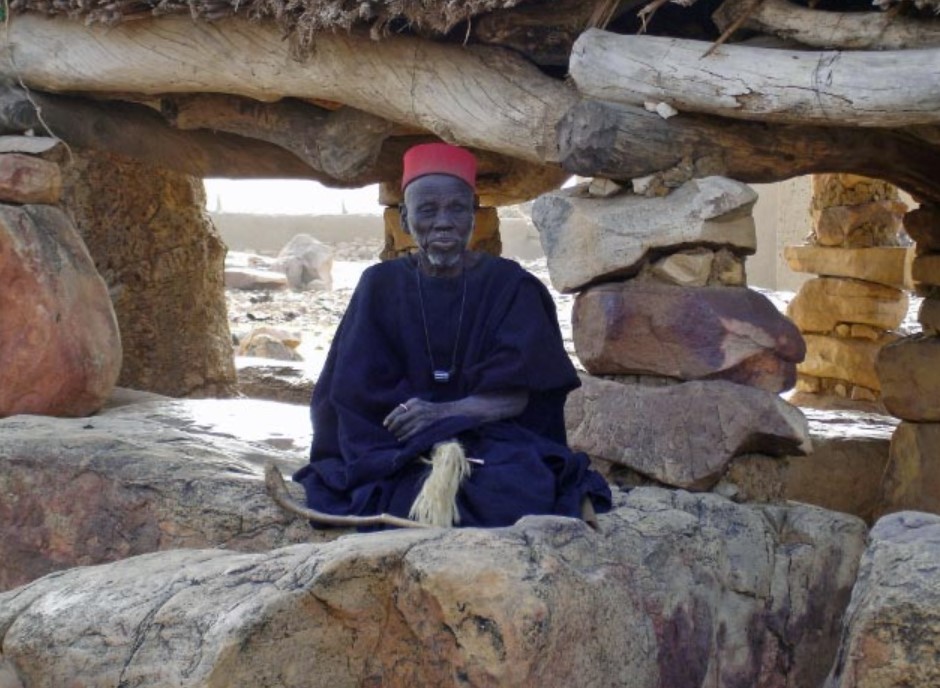 Senani P, CC BY-SA 3.0, Wikimedia Commons
Senani P, CC BY-SA 3.0, Wikimedia Commons
The Hogon’s Initiation
During the initiation, the Hogon cannot shave or wash himself, and no one is allowed to touch him.
He must wear white clothes, and a virgin is sent to clean his house and make his meals. At night, she returns to her house and Hogon is left in seclusion.
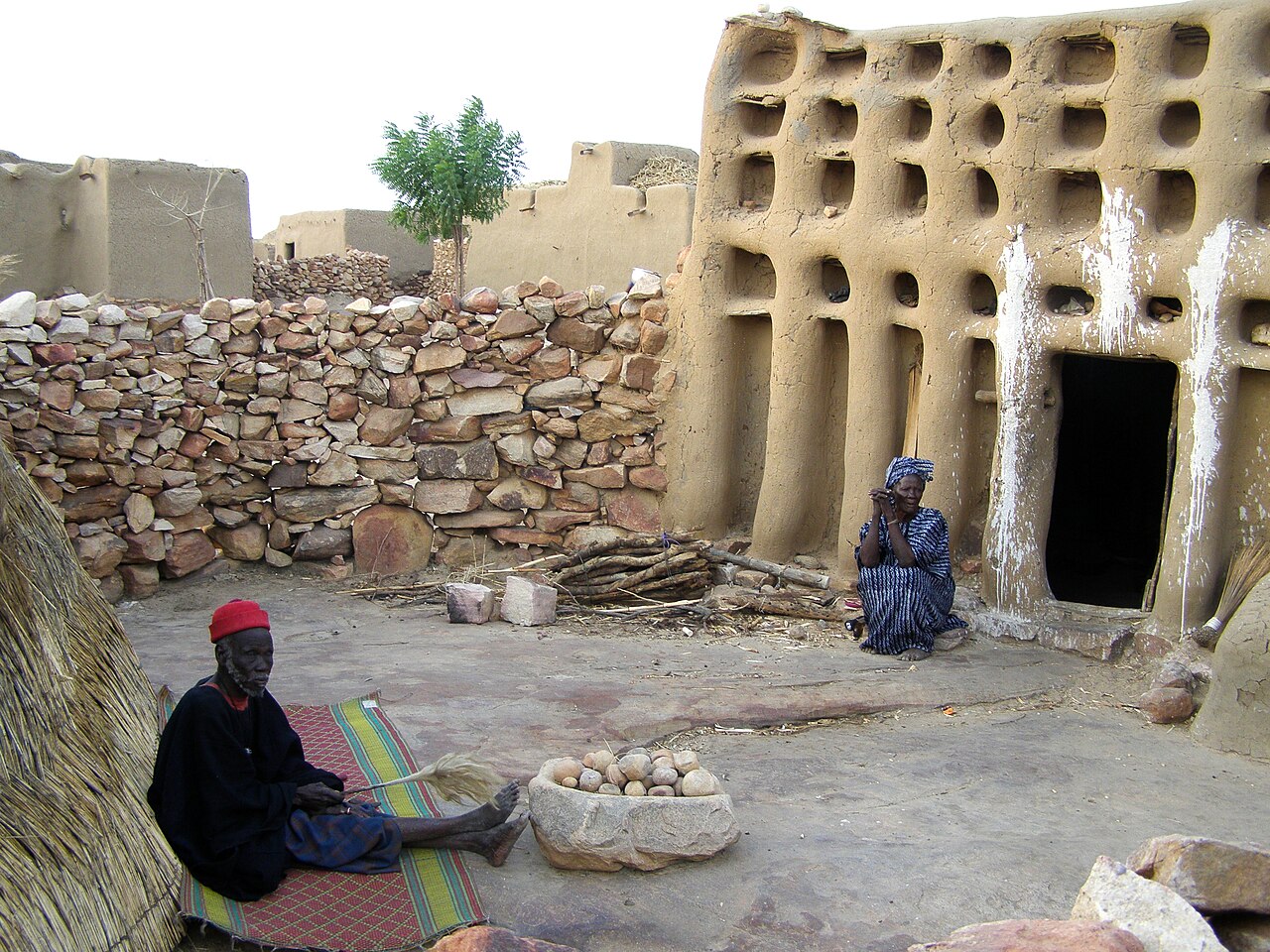 BluesyPete, CC BY-SA 3.0, Wikimedia Commons
BluesyPete, CC BY-SA 3.0, Wikimedia Commons
The Hogon’s Initiation (cont’d)
Once the Hogon passes the initiation period, his position is shown by wearing a red fez cap and an armband with a sacred pearl.
The Hogon’s wife may visit him during the day, but for the most part, he lives alone. It is believed that at night, the sacred Lebe snake visits the Hogon to cleanse him and give him wisdom.
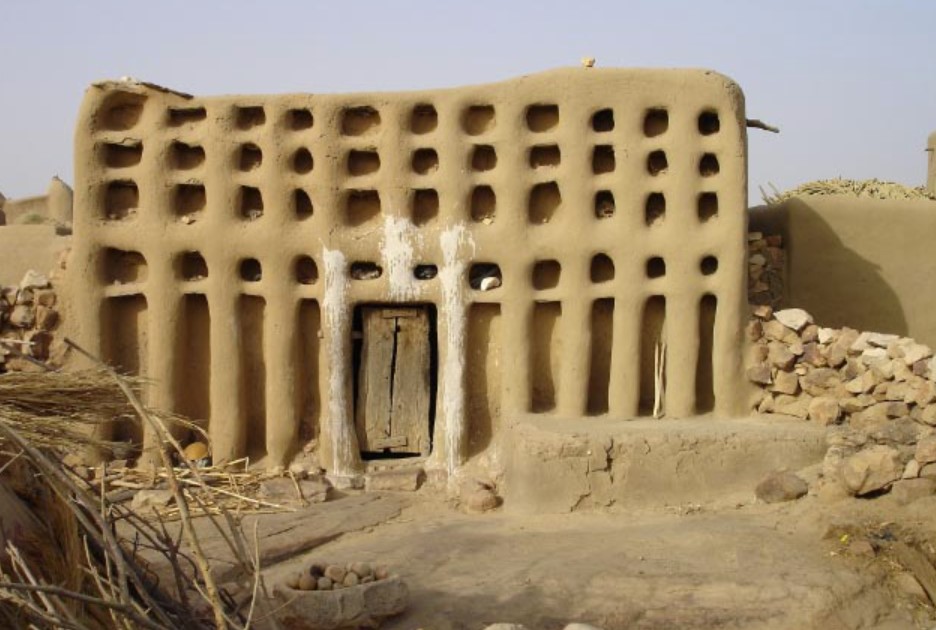 Senani P, CC BY-SA 3.0, Wikimedia Commons
Senani P, CC BY-SA 3.0, Wikimedia Commons
The Castes
In Dogon society, there are two main castes: the smiths and the leatherworkers.
Although these castes are related to jobs, people are born into their caste, and live at the edge of the village or in their own settlement nearby.
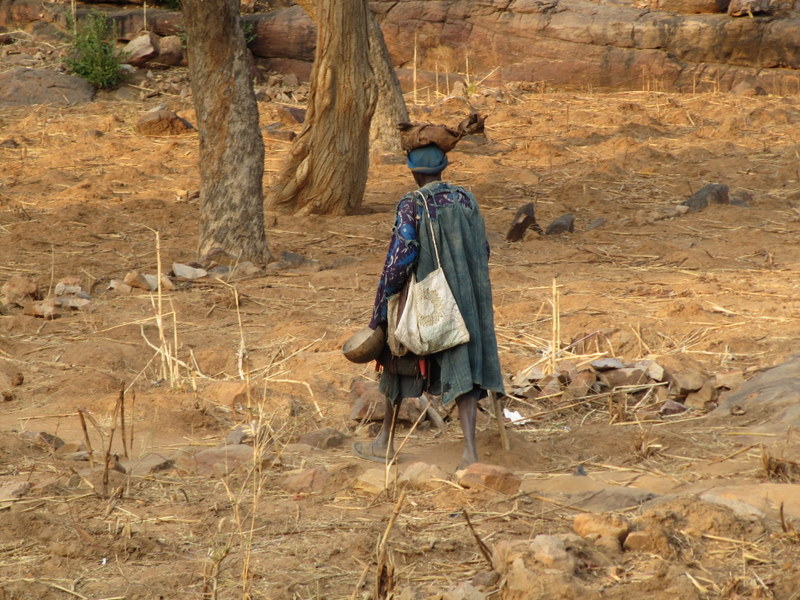 Martijn.Munneke , CC BY 2.0 , Wikimedia Commons
Martijn.Munneke , CC BY 2.0 , Wikimedia Commons
The Castes (cont’d)
In traditional Dogon beliefs, the smiths have spiritual powers that are useful in rituals, but they usually live in poverty.
The leatherworkers are the ones who go out and trade with other communities, and people from this caste a known for accumulating wealth.
Their Masks
Ceremonial masks are an important part of Dogon culture. There is even a community of masked dancers called the Awa.
Men who are part of the Awa must obey a strict code of conduct and speak a secret language called Sigi So.
The Sigi And Dama Rituals
The Awa play an important role in two major ceremonies: the sigi ritual and dama funeral rituals.
During the sigi ritual, everyone in the community comes together to honors the Dogon’s first ancestors. It is believed that the sigi originated as a way to facilitate peace between the Dogon, as every single village takes part in this ritual.
The Sigi Ritual
The sigi starts in the northeastern part of the Dogon’s territory, and each village will get a turn to host grand feasts and festivities.
The Awa perform dances at sigi ceremonies, and also carve new masks that they dedicate to the ancestors.
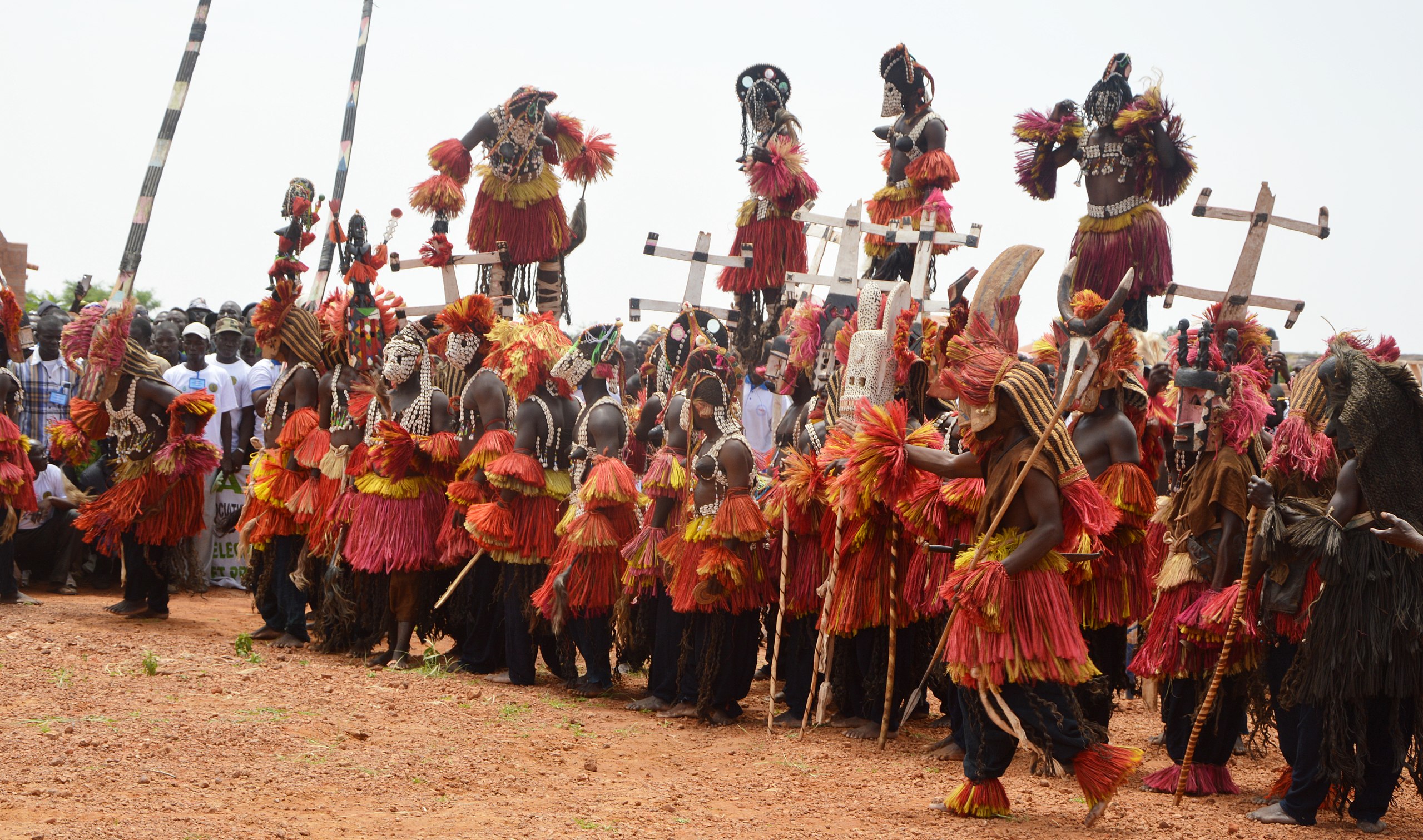 Fasokan, CC BY-SA 4.0 , Wikimedia Commons
Fasokan, CC BY-SA 4.0 , Wikimedia Commons
How Long Does The Sigi Last?
Every village celebrates the sigi for about a year. Then, it is the next village’s turn to host the ritual.
The Dogon begin the cycle of sigis every 60 years.
The Dama Ritual
As part of their funerary traditions, the Dogon have several rituals. The dama ritual is one of the most vibrant. During the dama, the Awa dancers put on a masquerade that is meant to guide the souls of the departed to the afterlife.
The Dama is a very expensive ritual, which has led to it becoming less common in Dogon villages. Many damas that are performed today are usually to showcase Dogon culture to tourists, and help the Dogon make some cash by charging for the show.
The Yingim And Danyim Rituals
In addition to the dama ritual, Dogon funerals also involve the yingim and danyim rituals. Both rituals take place once a year and are meant to honor elders who passed on since the last Dama.
The Yingim Ritual
During the yingim ritual, cattle or other valuable livestock are sacrificed and the Dogon participate in mock battles.
The Dogon believe that the battles chase the spirit out of the departed person’s body and away from the village, towards the afterlife.
The Danyim Ritual
The danyim ritual takes place a couple months after the yingim. During the danyim, the Awa perform dances each morning and evening for up to six days, depending on the traditions of the village.
The Awa dance on the rooftop of the departed person’s house and all throughout the village and surrounding fields. Until all the dances are complete, any bad luck in the village is blamed on the restless spirit of the departed.
The Meaning Of Their Masks
The Dogon have many different masks for different purposes. For example, the Satimbe mask is meant to honor women ancestors who learned that the masks should be used to guide the spirits of the departed.
The Sirige is another popular mask. It stretches high into the air and honors certain Dogon men who passed on.
How Do They Make The Masks?
The Dogon make their masks out of natural elements. They are usually carved out of wood and woven with hibiscus fiber. Shells and beads different colored cloths are also used to decorate Dogon masks.
The Spiritual Sects
There are five important spiritual affiliations, or sects, in Dogon society. The main one is the sect of Amma, the creator god.
During an annual ceremony, people offer boiled millet to Amma. They place the offering on a cone-shaped altar that is painted white.
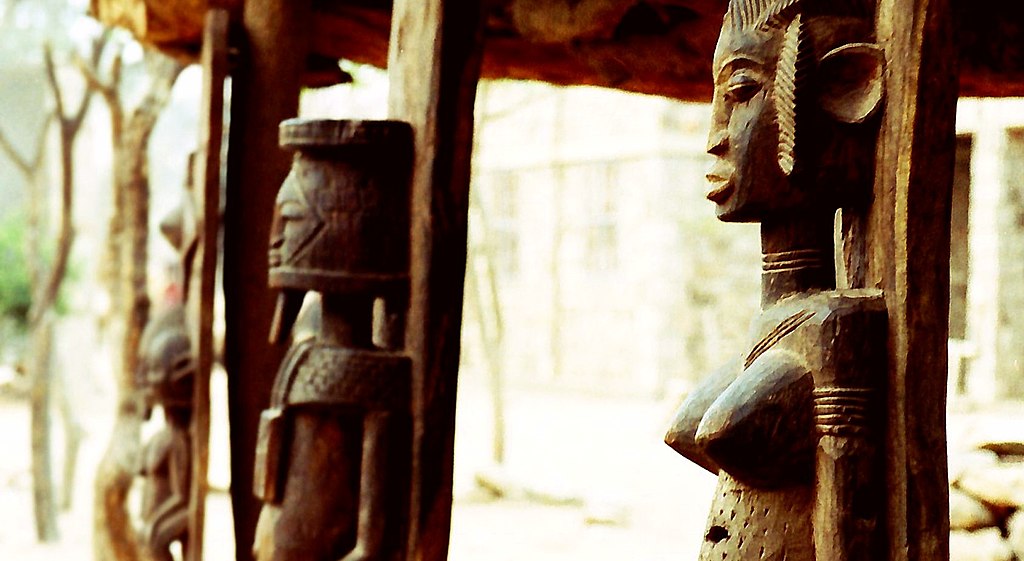 Dr. Ondřej Havelka, CC BY-SA 4.0, Wikimedia Commons
Dr. Ondřej Havelka, CC BY-SA 4.0, Wikimedia Commons
The Sigi Sect
The men who organize the sigi ceremonies are part of a secret society called the Olubaru. The Olubaru are feared by other villagers and people are warned to stay in at night, when the Olubaru are out and about.
Every 60 years, the Olubaru make a huge mask, called the Great Mask, to honor the Dogon’s original ancestors.
The Binou Sect
Totems are an important aspect of the Binou sect. Dogon priests often have their own individual totems, and there is usually a totem animal on a Binou altar for the whole village.
Buffalo, crocodile, and panther totems are the most recognizable in Dogon communities.
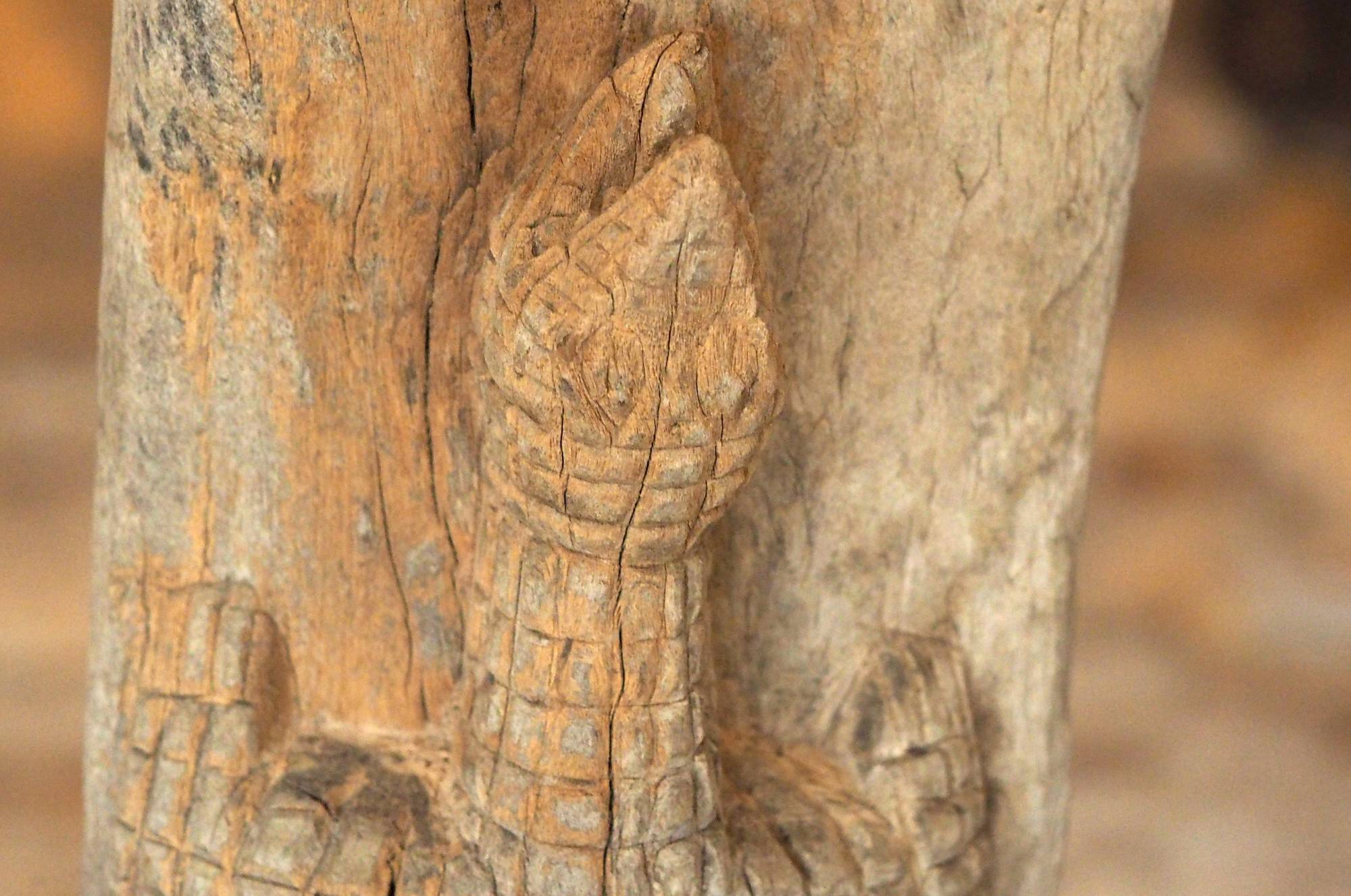 Ann Porteus , CC BY 2.0, Wikimedia Commons
Ann Porteus , CC BY 2.0, Wikimedia Commons
The Binou Sect (cont’d)
People are not allowed to eat meat or use hides from their totem animals. For example, if someone with a buffalo totem eats buffalo meat or even see a buffalo die, they must make a purification sacrifice of boiled millet, goats, and chickens.
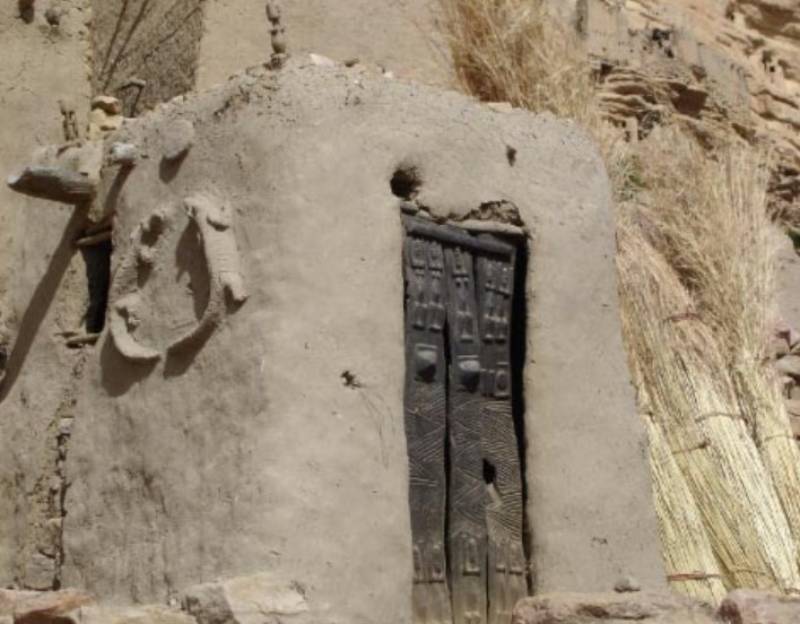 Senani P , CC BY-SA 3.0 , Wikimedia Commons
Senani P , CC BY-SA 3.0 , Wikimedia Commons
The Lebe Sect
The Lebe sect worships Lebe Serou, a Dogon ancestor who is believed to have been the first human being. In their myth, Lebe was turned into a snake, and once a year, the Dogon hold a three-day celebration to honor Lebe.
The Twin Sect
Twins are seen as good luck in Dogon communities. When a pair of twins are born, the community gathers to perform rituals in which they evoke their ancestors.
They also pay homage to the divine Nummo twins.
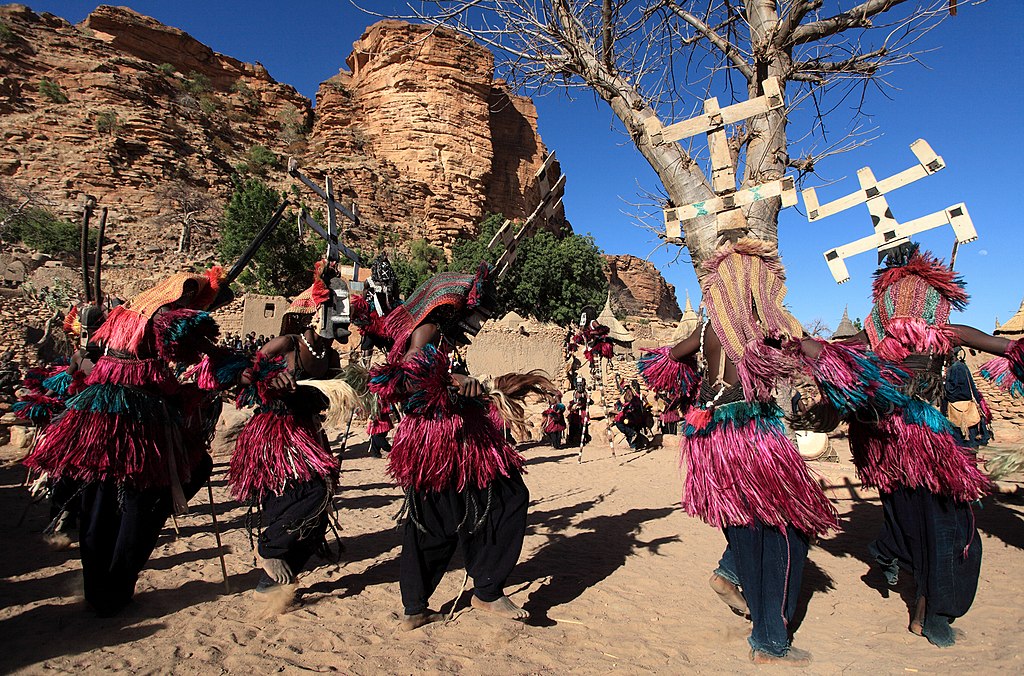 Hisashi Yuya, CC BY-SA 4.0, Wikimedia Commons
Hisashi Yuya, CC BY-SA 4.0, Wikimedia Commons
The Mono Sect
The Mono sect is for unmarried young men. There is a Mono altar in each village, and every January or February, the men spend a night gathered around the altar.
During the celebration, they scream, sing, and wave torches. They also hunt or mice, which are given as sacrifices on the altar at dawn.
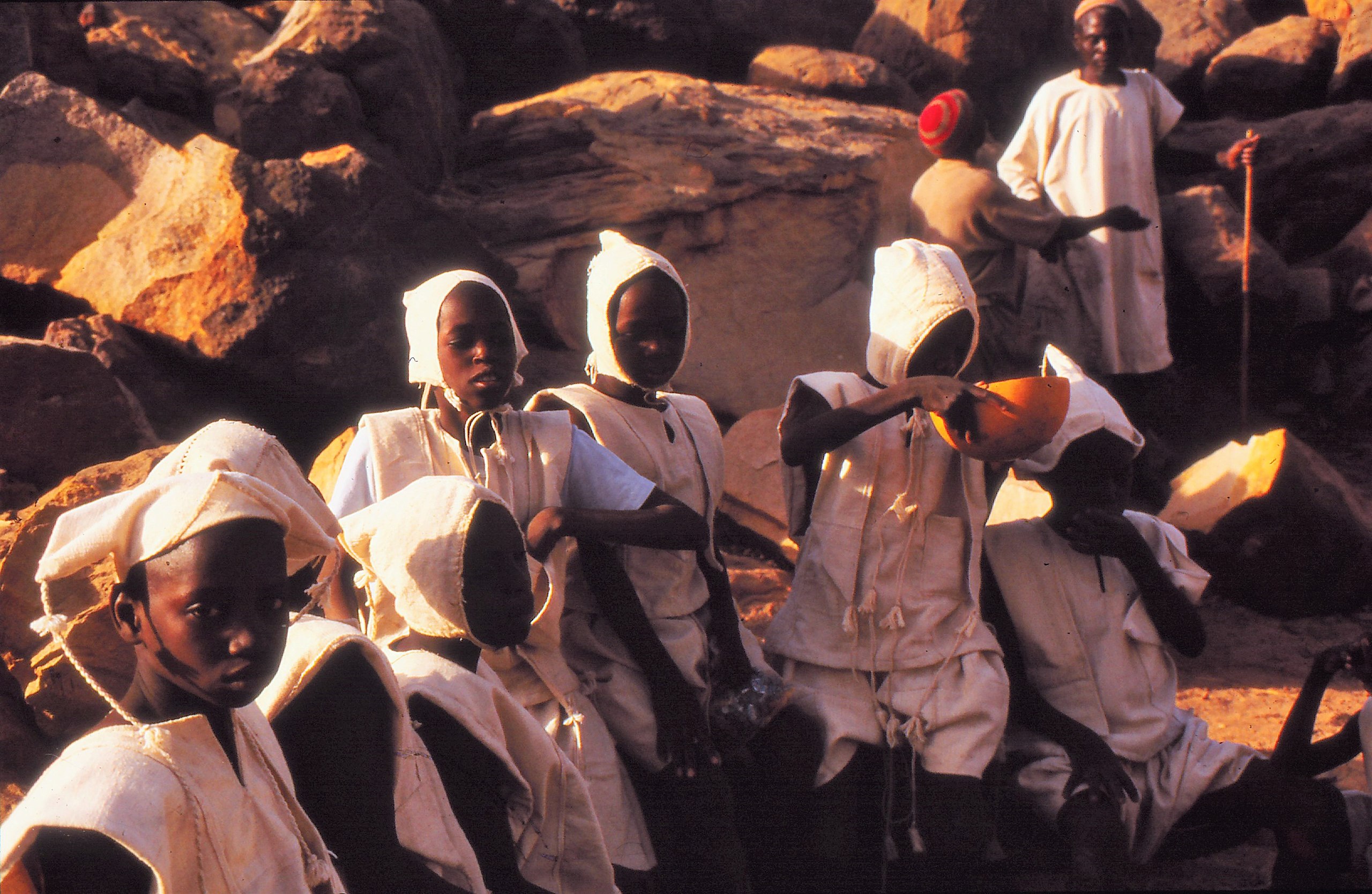 W.E.A. van Beek, CC BY-SA 4.0, Wikimedia Commons
W.E.A. van Beek, CC BY-SA 4.0, Wikimedia Commons
Dogon Villages
Dogon villages are usually made up of about 44 houses that are built close together, sometimes even sharing walls.
The houses are organized around the leader’s house. Dogon villages are usually made up of one large extended family, though sometimes multiple lineages make up a village.
The Male Granary
The Dogon have two different types of granaries for men and women. The male granary is built with a pointed roof and is fortified against mice and other pests. They use this granary to store grains like pearl millet.
The number of stocked male granaries is a signifier of a village’s wealth and size.
The Female Granary
The female granary looks like the male granary, though it is a bit less protected from pests. Women can store their personal belongings like jewelry and money in their granary and maintain a level of economic independence.
Men are prohibited from entering female granaries.
The Toguna
The toguna is a large hut that is only for Dogon men. During days in the dry season, the men spend much of their day in the toguna.
This is also where they discuss important village affairs. The toguna is built low, so that the men cannot stand upright. This is meant to keep them from erupting into violence during heated discussions.
The Punulu
The punulu is where Dogon women go when they’re menstruating. Women are considered to be unclean during this time, so the punulu is on the outskirts of the village and women must stay there during their cycle.
They are allowed to bring their youngest children with them and must use tools and utensils that are kept at the punulu.
What Do They Eat?
The Dogon are excellent farmers, and this is how they get most of their food. Millet, sorghum, and rice are common staple crops.
Peanuts and onions are also grown, with the sale of onions being the driving force of the economic growth in the Sangha region.
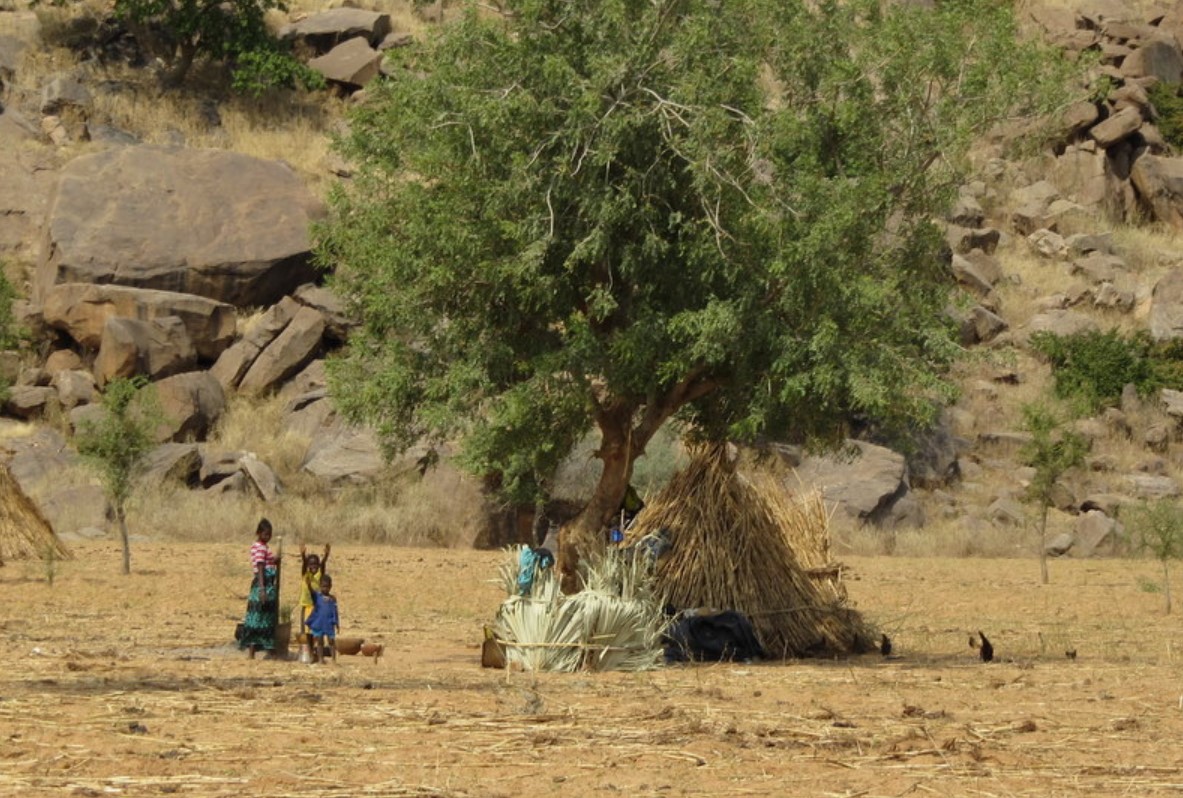 Martijn.Munneke, CC BY 2.0, Wikimedia Commons
Martijn.Munneke, CC BY 2.0, Wikimedia Commons
What Do They Eat? (cont’d)
In addition to farming, Dogon women also forage for wild fruits, nuts, tubers, and honey.
Wild game is scarce near Dogon villages, so there’s not much opportunity for hunting. Instead, they keep lots of livestock, like chicken, sheep, and goats.
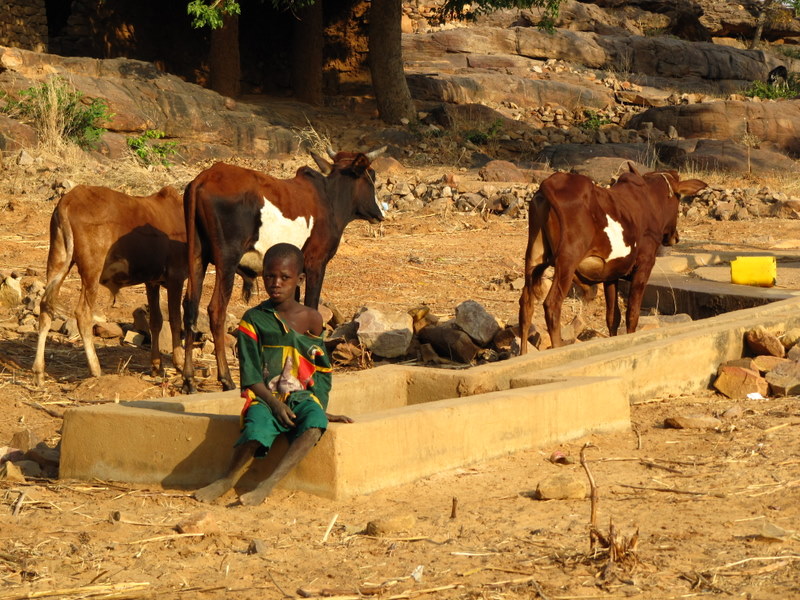 Martijn.Munneke , CC BY 2.0 , Wikimedia Commons
Martijn.Munneke , CC BY 2.0 , Wikimedia Commons
What Language Do They Speak?
The Dogon language is thought to belong to the Niger-Congo language family, though there is little evidence to support this.
There are many different dialects of the Dogon language, including ancient dialects that are still used in their ritual chants and prayers.
What Language Do They Speak? (cont’d)
In the south of Mali, there are seven villages who speak the Bangime language, which unlike any of the other Dogon dialects.
It is believed that the 1,500 people who speak this language are actually using an ancient language that predates the Dogon language.
Final Thoughts
With their colorful traditions and fascinating mythology, it’s easy to see why tourists are captivated by the Dogon people. Their rituals and ceremonies have made them a major attraction in Mali, but most of their fame still centers around the extraterrestrial origins.
Despite years of efforts from scientists and anthropologists around the world, we still can’t explain how the Dogon accurately charted the stars, or how they know there could be a third undiscovered star in the Sirius system.
So, were the Dogon really visited by aliens? You’ll have to come to that conclusion on your own.

